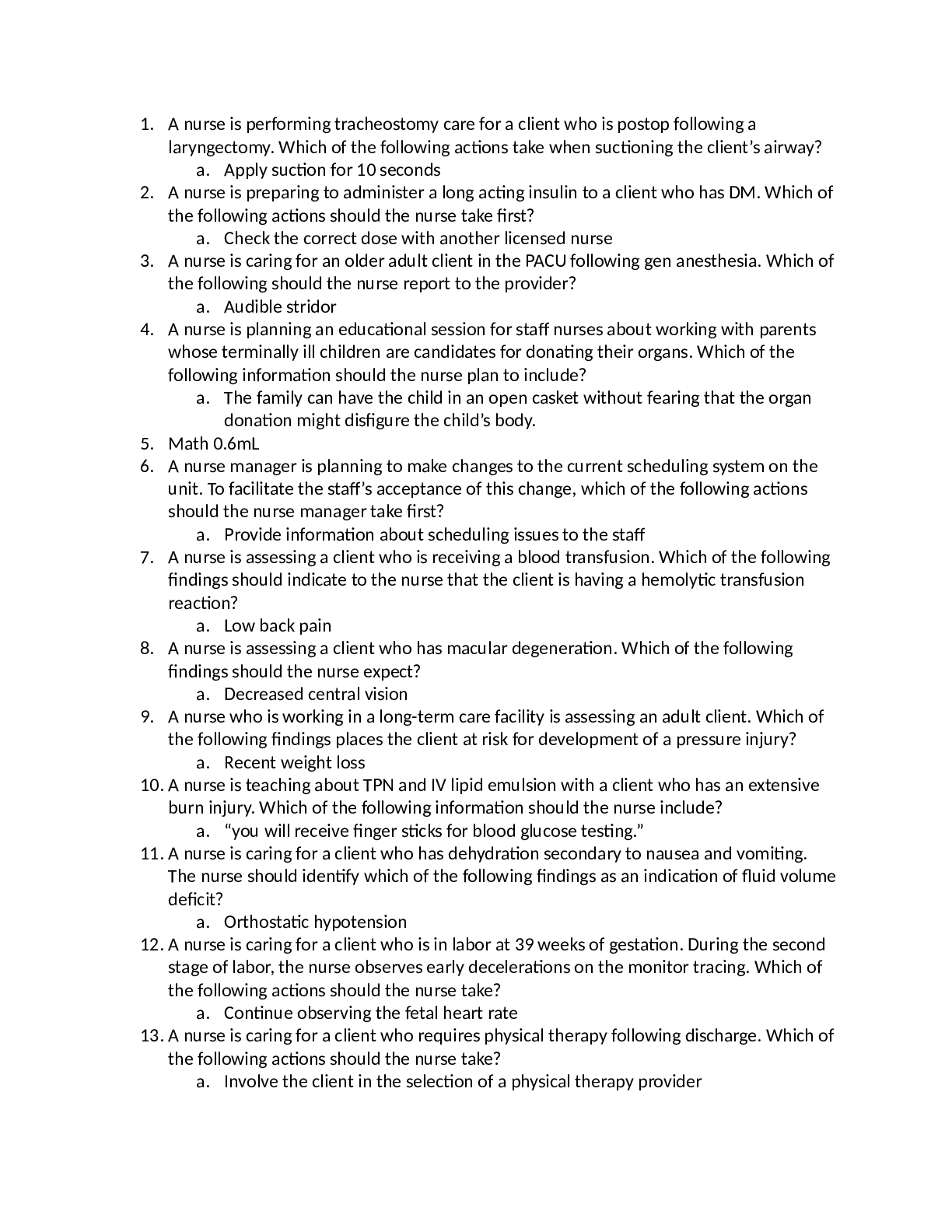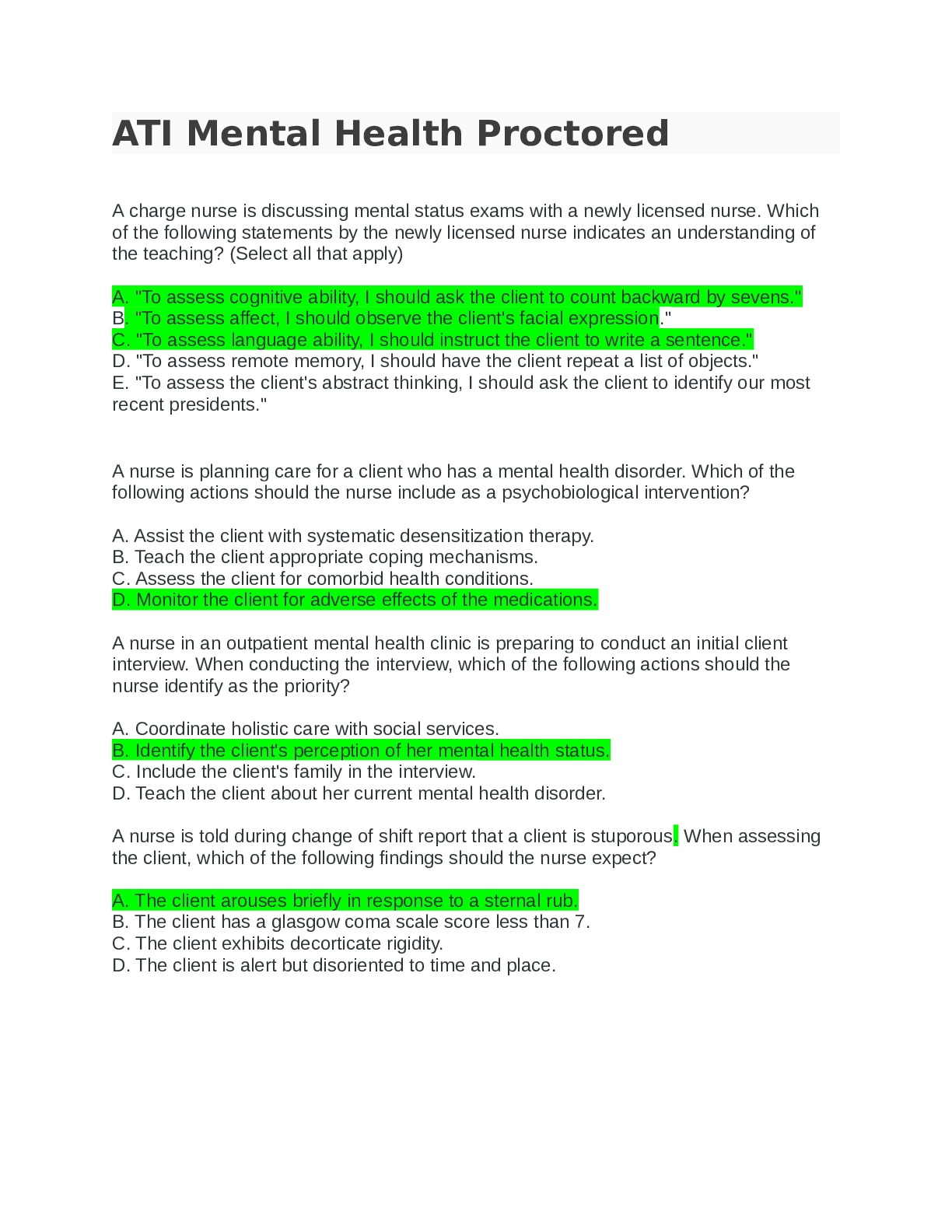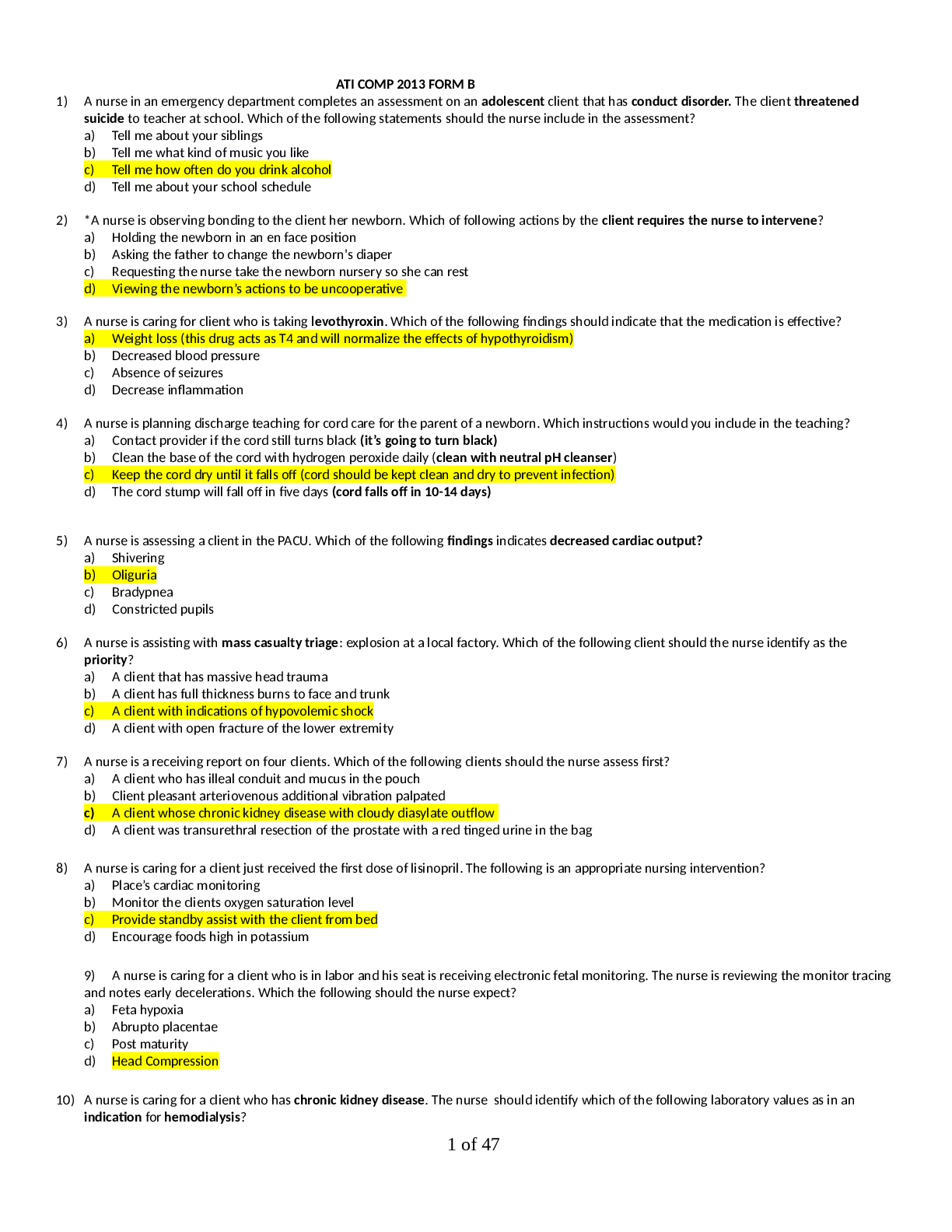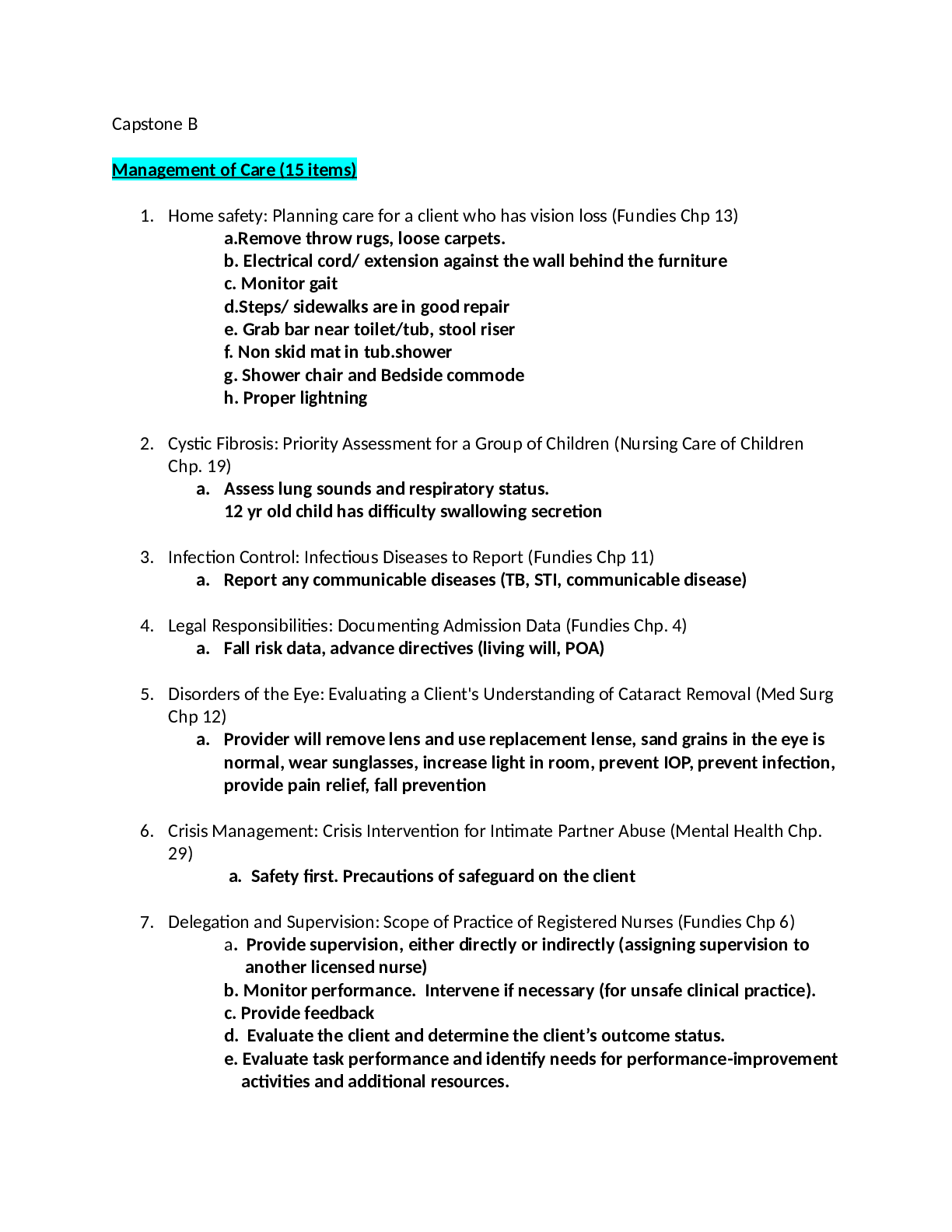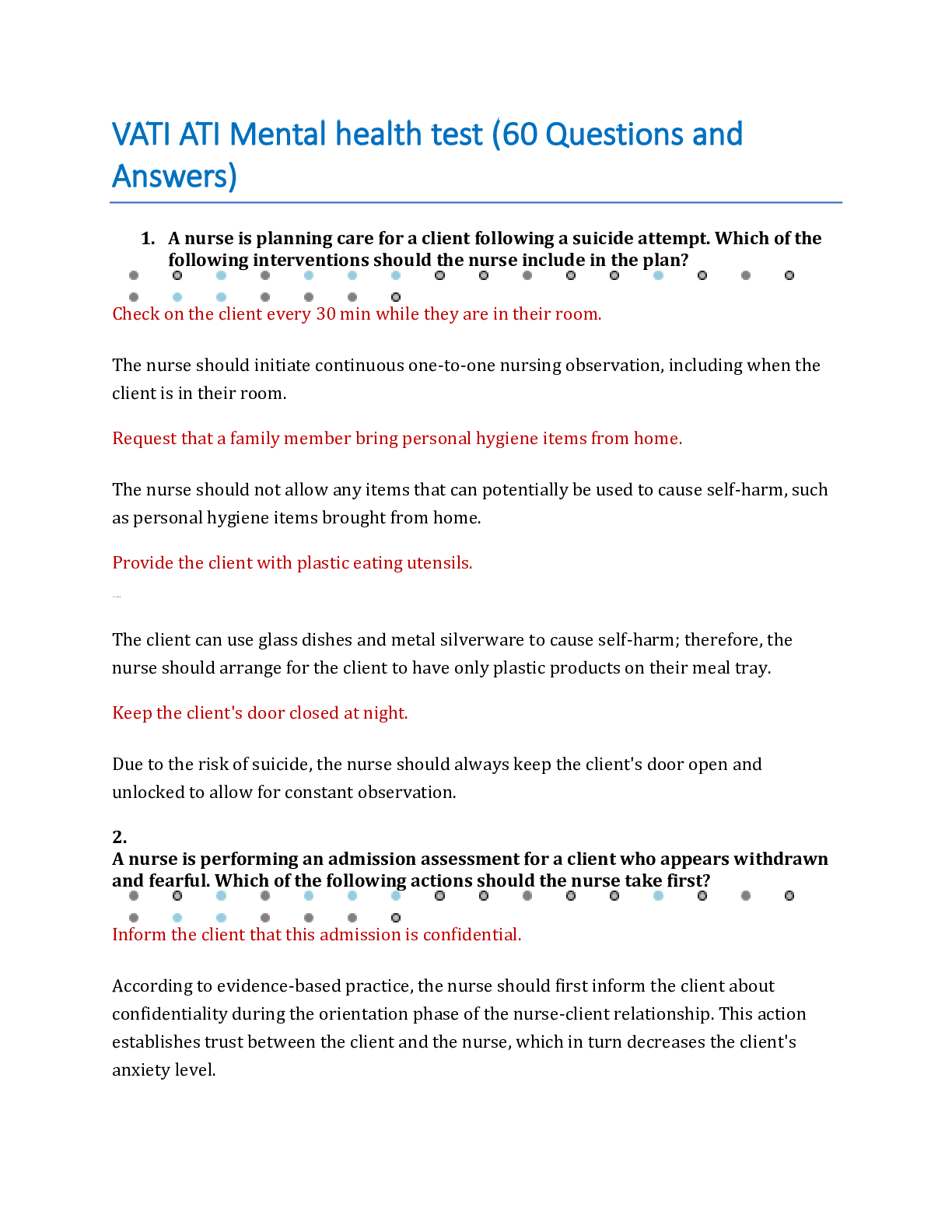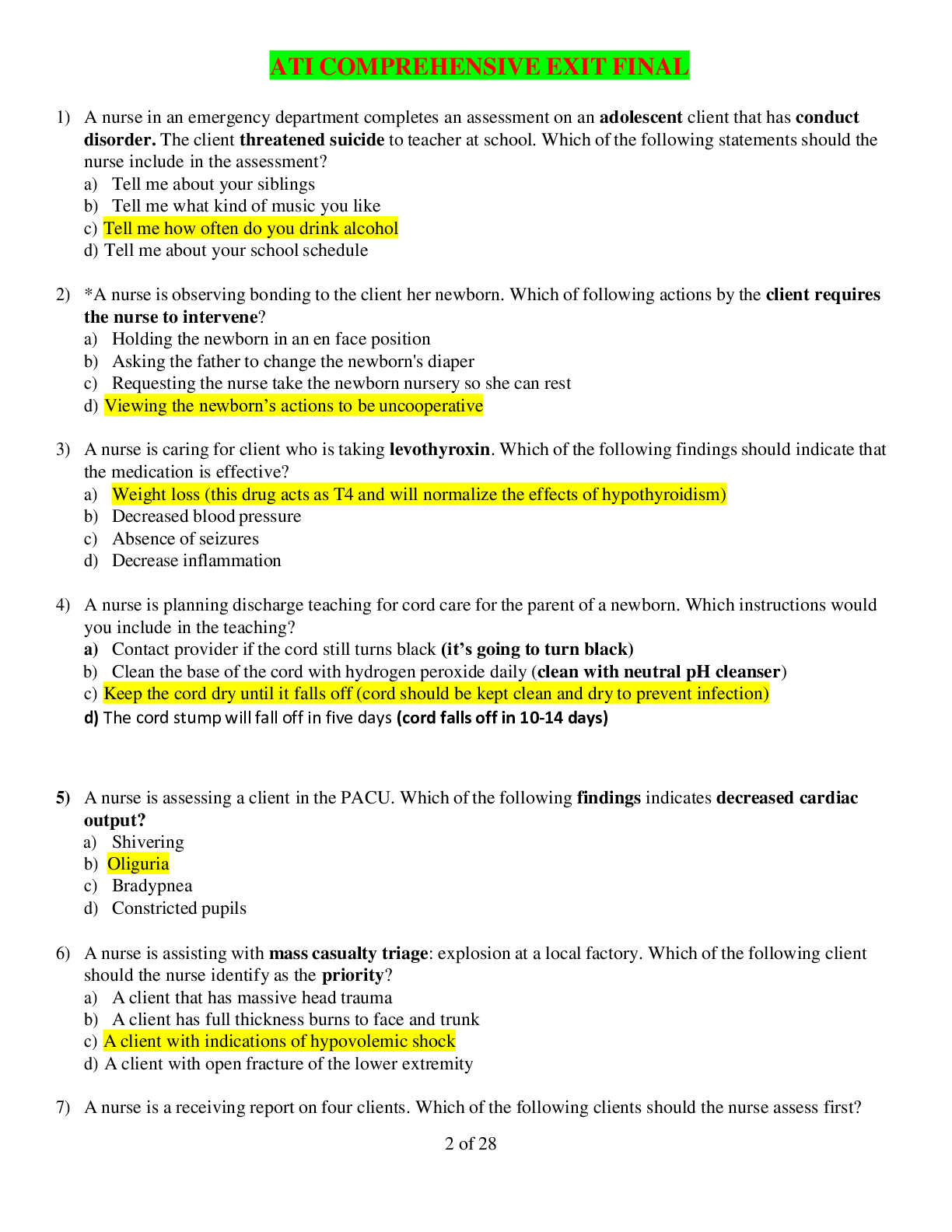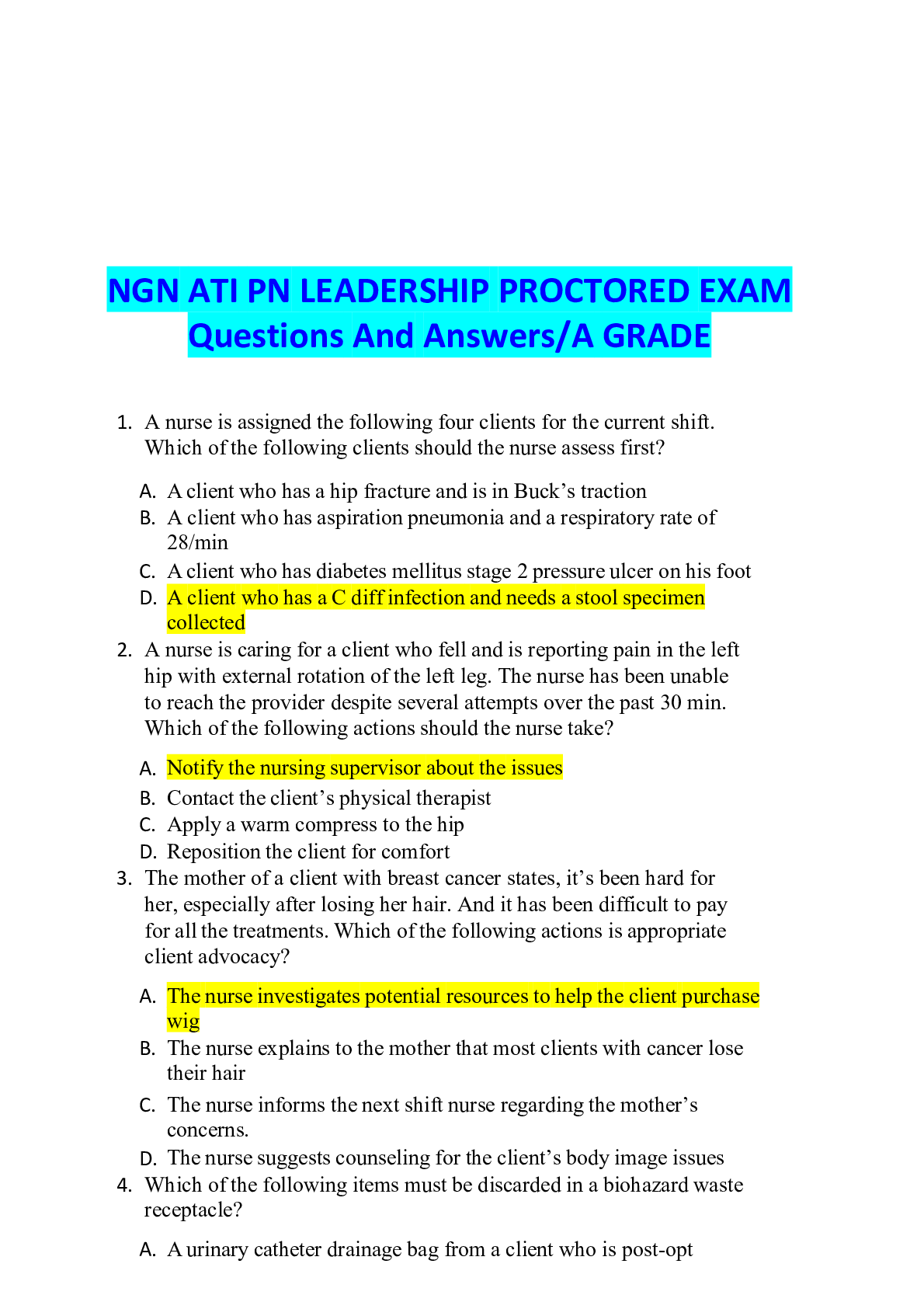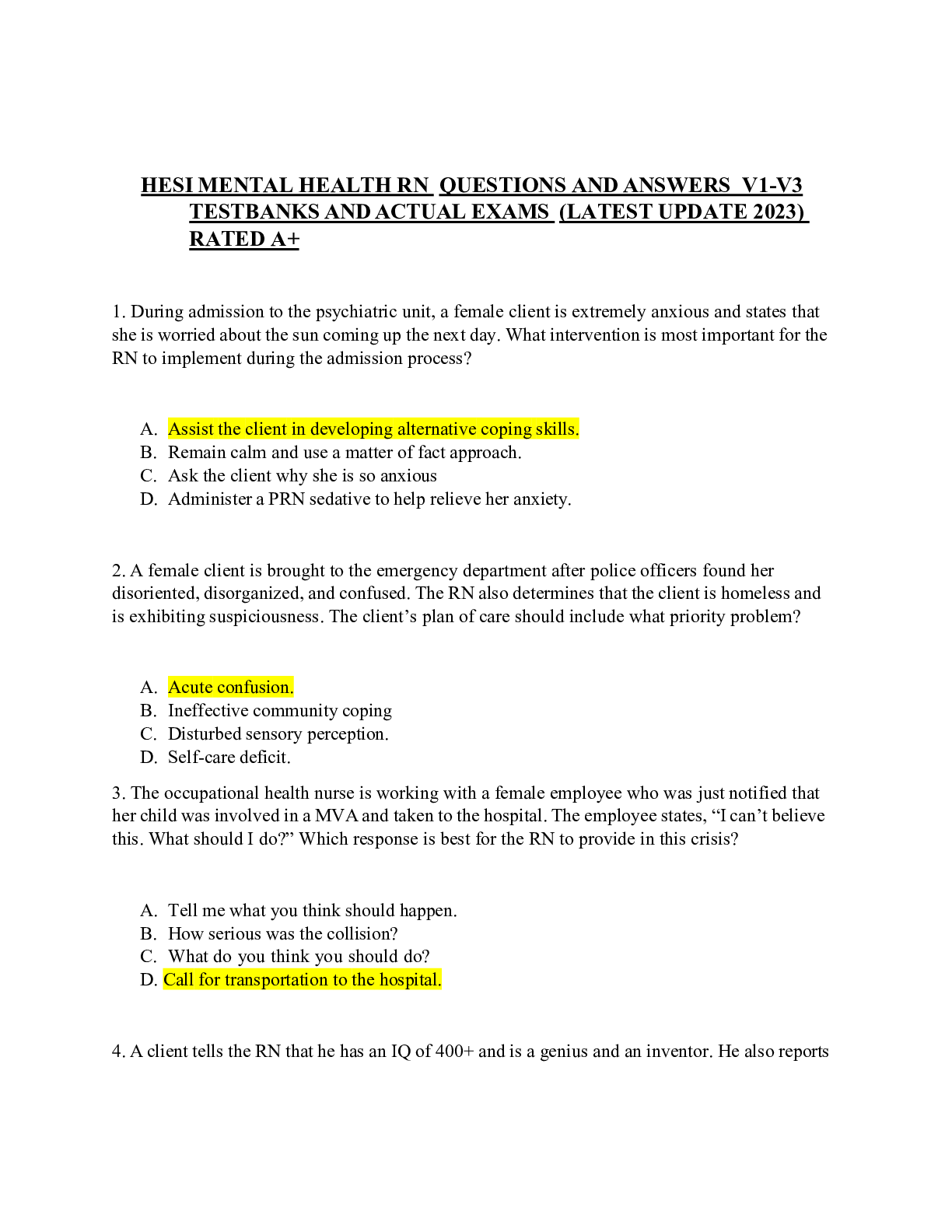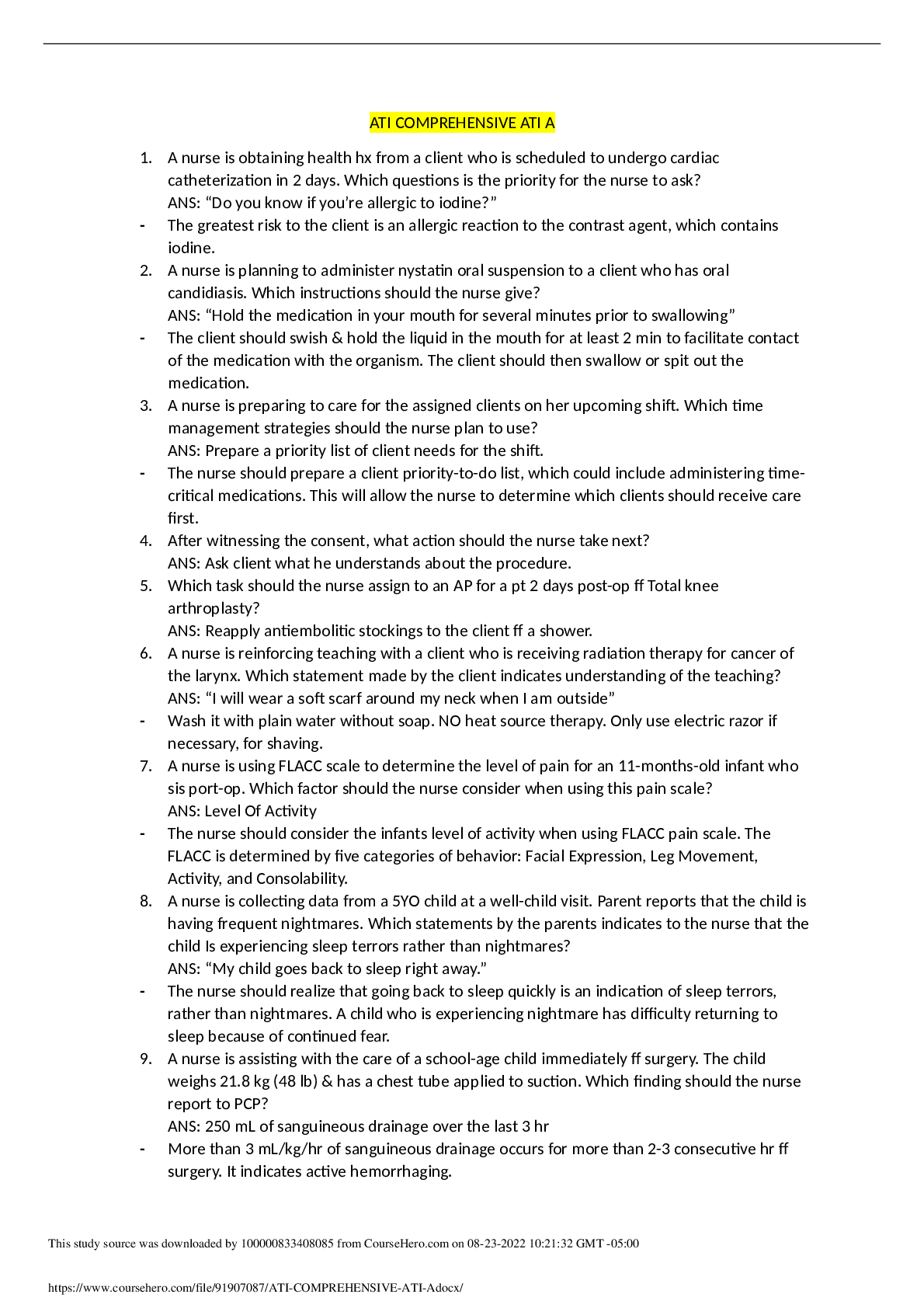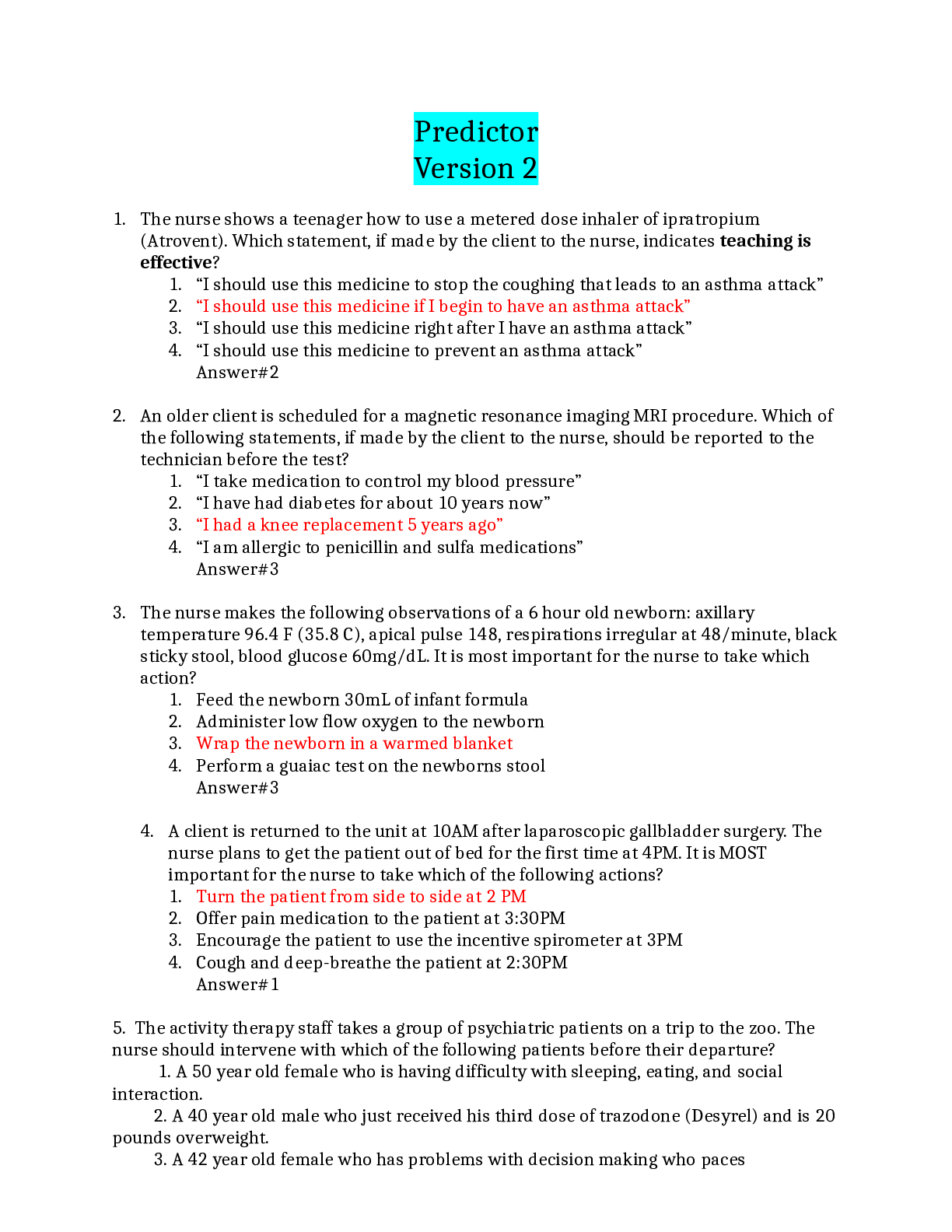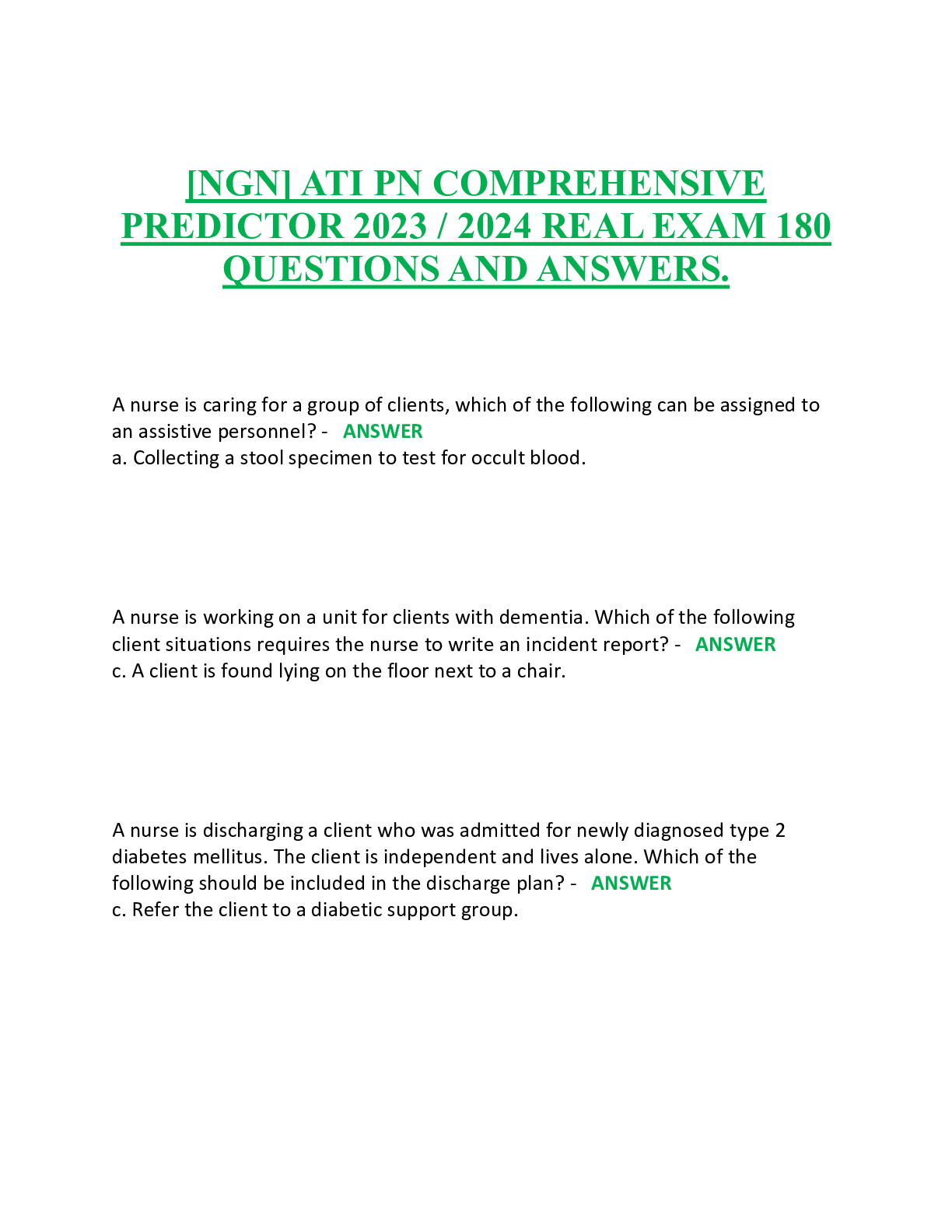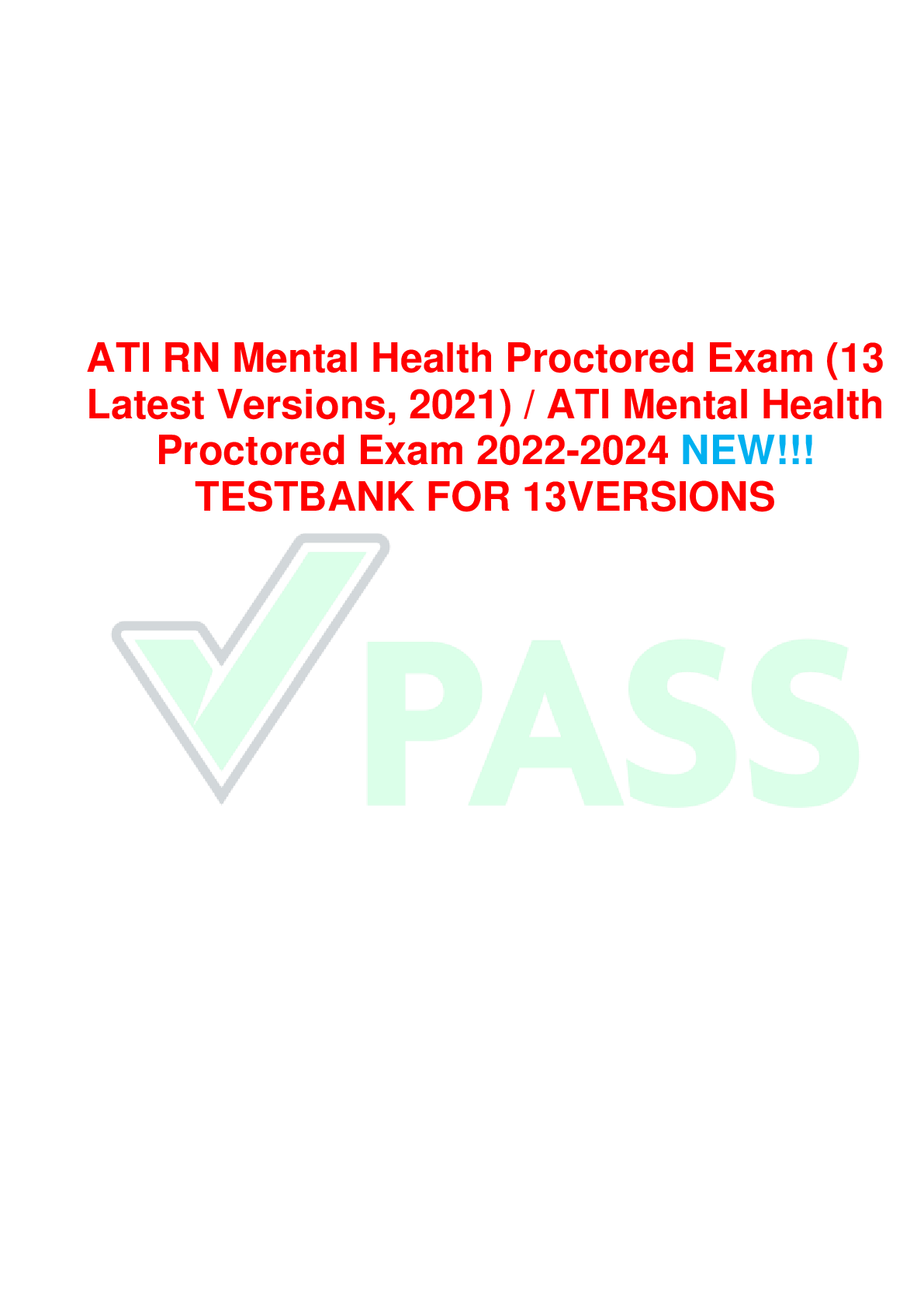NURSING 4764 ATI Mental Health 2019 B Practice Questions And Answers
Document Content and Description Below
Mental Health 2019 B Practice 1) A nurse is assessing a family’s dynamics during a counseling session. The nurse should recognize which of the following findings as an indication of a boundary issu... e? -An adolescent family member who questions parental authority An adolescent who questions parental authority is demonstrating appropriate behavior for developmental age. -A family with three generations in the same household This scenario occurs in many households, and it is not an indication of a boundary issue. -Older children who are responsible for their younger siblings This is an example of enmeshed boundaries in which there are no distinctions between the roles of family members. -Two adults and their children from prior relationships in the same household This is an example of a blended family, and it is not an indication of a boundary issue. 2) A nurse is performing an admission assessment on a client and notices that the client appears withdrawn and fearful. To establish a trusting nurse client relationship. Which of the following actions should the nurse take first? -Inform the client that this admission is confidential. According to evidence-based practice, the nurse should first inform the client about confidentiality during the orientation phase of the nurse-client relationship. -Introduce the client to other clients in the day room. The nurse should introduce the client to other clients in the day room to help the client interact with others during the working phase of the nurse-client relationship. However, evidence-based practice indicates that the nurse should take a different action first. -Assist the client in facilitating behavioral change. The nurse should assist the client with behavioral change during the working phase of the nurse-client relationship. However, evidence-based practice indicates that the nurse should take a different action first. -Determine coping strategies that the client has used in the past. The nurse should determine what coping strategies the client used in the past during the working phase of the nurse-client relationship. However, evidence-based practice indicates that the nurse should take a different action first. 3) A nurse is performing a cognitive assessment to distinguish delirium from dementia in a client whose family reports episodes of confusion. Which of the following assessment findings supports the nurse’s suspicion of delirium? -Slow onset Delirium has an acute onset. Dementia is a slow, progressive decline. -Aphasia Aphasia is a manifestation of dementia. -Confabulation Confabulation is a manifestation of dementia. -Easily distracted Extreme distractibility is a hallmark manifestation of delirium. 4) A nurse is caring for an older adult client who is experiencing delirium. Which of the following interventions should the nurse include in the client’s plan of care? -Offer the client various choices for meal selection. The nurse should provide a client who has delirium with a plan of care that decreases agitation and anxiety by limiting the choices the client is asked to make. -Assign different nursing personnel for each shift. The nurse should provide a client who has delirium with a plan of care that decreases agitation and anxiety by providing consistent nursing personnel. -Permit the client to perform daily rituals to decrease anxiety. The nurse should provide a client who has delirium with a plan of care that decreases agitation and anxiety by permitting the client to perform daily rituals. -Maintain an environment that has low lighting. The nurse should provide a client who has delirium with a plan of care that decreases agitation and anxiety by providing a well-lit environment. 5) A nurse is planning care for a newly admitted client who has bipolar disorder and is experiencing mania. Which of the following interventions should the nurse include in the plan of care? -Encourage the client to participate in group therapy. The nurse should maintain a low-stimuli environment for a client who is experiencing mania. The nurse should dim the lights, decrease noise, and limit the number of people the client is around. -Instruct the client to avoid napping during the day. The nurse should encourage the client to take frequent rest periods throughout the day. Clients experiencing mania are at risk of exhaustion that can be life threatening. -Offer the client high-calorie finger foods frequently. The nurse should frequently offer the client high-calorie foods that can be eaten while the client is on the go. Clients experiencing mania might be unable to sit down for meals and can experience weight loss and dehydration. -Decrease the client's daily fiber intake. The nurse should encourage the client to eat foods and snacks that are high in fiber. Clients experiencing mania can experience dehydration and nutritional deficiencies from decreased intake, which can lead to constipation. 6) A nurse is teaching the partner of a client who has bipolar disorder how to identify manifestations of acute mania. Which of the following findings should the client's partner report to the provider? -Obsessive attention to detail During the manic phase of bipolar disorder, a client's behavior becomes disorganized and chaotic, which renders the client unable to focus on detail. -Inability to sleep During acute mania, the client is extremely active and does not sleep, which can lead to exhaustion. Therefore, the nurse should instruct the partner to report this finding. -Reports of fatigue Although the client who is experiencing acute mania might eventually become exhausted, there is a characteristic unawareness of fatigue during this phase. -Isolation from others Clients who are in the manic phase of bipolar disorder often talk and joke incessantly and are highly interactive. 7) A nurse is caring for a client who is experiencing a panic attack. Which of the following actions should the nurse take? -Orient the client to person, place, and time. A client who is experiencing a panic attack is generally not disoriented. -Assist the client with deep-breathing exercises. Relaxation techniques, such as deep, abdominal breathing exercises, help defuse manifestations of anxiety. -Calm the client by using therapeutic touch. Therapeutic touch is not intended to de-escalate panic in a client who is anxious. -Have the client sit alone in a quiet room. It is recommended that the nurse stay with a client who is experiencing panic anxiety to ensure the client's safety. 8) A nurse is talking with a group of parents who have recently experienced the death of a child. Which of the following actions should the nurse take? -Encourage the parents to avoid discussing the death with their other children to protect their feelings. Siblings also experience feelings of intense grief and need to know it is acceptable for the family to grieve together. -Recommend each parent grieve in private to avoid hindering each other's healing. Although parents tend to grieve differently, it is important they share their grief and communicate their needs to decrease the likelihood of marital upset. -Suggest forming a weekly support group for parents who have experienced the death of a child. Support groups are a positive resource in the process of recovery for parents following the death of a child. -Advise the parents to begin counseling if they are still grieving in a few months. The grief process varies for each individual. Setting an expected period for grief places the parents at risk for further problems if they feel they have not completed the grieving process in an acceptable amount of time. 9) A nurse is teaching a group of newly licensed nurses about the use of mechanical restraints. Which of the following information should the nurse include in the teaching?10) -Complete documentation about the client's status every hour while they are in restraints. The nurse should document the client's status, including behavior and vital signs, and address the client's physical and safety needs every 15 min. -Maintain the client in restraints for a minimum of 4 hr. Restraints should be removed as soon as the client is able to follow instructions, control their behavior, and is no longer at risk for injuring themselves or others. The maximum amount of time an adult client should remain in restraints is 4 hr. -Apply restraints when other means of managing the client's behavior have failed. According to the Patient Self-Determination Act, clients have a right to be free from restraints or seclusion unless the safety of the client or others is at risk. De-escalation methods for controlling behavior should be attempted prior to initiating restraints. -Request that the provider assess the client within 8 hr of the application of restraints. The use of mechanical restraints requires a provider's prescription. In emergent cases, the prescription can be obtained after restraints have been applied. However, the provider must evaluate the client within 1 hr of the initiation of restraints 10) A nurse is assessing a client who is experiencing opioid withdrawal. Which of the following manifestations should the nurse expect? -Sedation The nurse should expect the client experiencing opioid withdrawal to have insomnia. -Rhinorrhea The nurse should expect the client who is experiencing opioid withdrawal to have rhinorrhea and flu-like manifestations such as yawning, sneezing, and abdominal pain. -Bradycardia The nurse should expect the client experiencing opioid withdrawal to have tachycardia. -Hypothermia The nurse should expect the client experiencing opioid withdrawal to have hyperthermia. 11) A nurse is facilitating a community meeting for acute care clients. One client is constantly talking and using the majority of the group’s time. Which of the following interventions should the nurse implement? -Tell the client to talk less or risk being removed from the meeting. Threatening the client is not a therapeutic intervention. -Ask group members to discuss their feelings about this client's monopolizing behavior. This intervention will validate other members' feelings toward the client who is dominating the meeting. It also should encourage group problem-solving. -End the group meeting and take the client aside to discuss the disruptive behavior. This intervention is punitive to all members of the group, and it does not address the problem within the group setting. -Focus on other group members and ignore the client who is doing all the talking. Ignoring the client does not address the behavior and is unlikely to solve the problem. 12) A nurse is assessing a client who has bulimia nervosa. The nurse should expect which of the following findings? -Amenorrhea A client who has anorexia nervosa is more likely to have amenorrhea resulting from low body weight. -Lanugo A client who has anorexia nervosa is more likely to have lanugo resulting from extreme malnutrition. -Cold extremities A client who has anorexia nervosa is more likely to have cold extremities from extreme malnutrition. -Tooth erosion A client who has bulimia nervosa is likely to have dental caries and tooth erosion caused by frequent exposure to gastric acid from vomiting. 13) A nurse in a community health center is working with a group of clients who have post traumatic stress disorder. Which of the following interventions should the nurse include to reduce anxiety among the group’s members? -Response prevention Response prevention is used in the treatment of compulsive behavior. -Guided imagery Guided imagery involves assisting the client to imagine a restful and safe place. This method is effective in reducing anxiety in clients who have post-traumatic stress disorder. -Aversion therapy Aversion therapy is a negative feedback method used to treat alcohol use disorder, violent behavior, and self-mutilation. -Light therapy Light therapy is used in the treatment of seasonal affective disorder, a type of depression. 14) A nurse is preparing to discharge to home an older adult client who attempted suicide. The client lives alone and has difficulty performing ADLs. Which of the following referrals should the nurse initiate? Select all that apply -Occupational therapy is correct. An occupational therapist can assist the client to perform ADLs. -Meal delivery services is correct. Meal delivery services are necessary due to the client's difficulty performing ADLs. -Physical therapy is correct. A physical therapist can assess the client's mobility needs and assist with ADLs. -Home health services is correct. Home health services provide a nursing assessment of the client's physical and mental status, as well as assistance with ADLs. -Speech-language pathologist There is no indication that the client needs a referral for a speech-language pathologist. This referral would be indicated if the client had difficulty swallowing. 15) A nurse at a provider’s office is interviewing an older adult client. Which of the following actions should the nurse plan to take? Click on the exhibit button -Use a screening tool to evaluate the client for depression. Depression can be underdiagnosed among older adult clients. The nurse should identify several risk factors for depression from the client's data, including having Alzheimer's disease, anxiety, and the loss of a loved one. Manifestations of depression can also be nonspecific for older adult clients and can include weight loss, decreased energy levels, and difficulty sleeping. -Ask the provider to decrease the dosage of the client's blood pressure medication. The client's blood pressure is within the expected reference range; the nurse should identify a systolic blood pressure of less than 90 mm Hg as hypotension. -Instruct the client to decrease intake of vitamin B12. After age 50, the body's ability to absorb vitamins can decrease. Although the older adult client takes a multivitamin daily, the nurse should instruct the client to ensure adequate intake of vitamin B12 through fortified foods, such as whole-grain products. -Suggest the client go for a brisk walk 20 min just before bedtime. Exercise can help promote sleep; however, the nurse should instruct the client not to exercise just prior to bedtime because this might worsen insomnia. 16) A nurse is planning care for a client who has made repeated physical threats toward others on the unit. Although the client does not want to leave the unit, the nurse request the provider to transfer the client to a unit that is equipped to manage violent behavior. Which of the following ethical principles should the nurse apply in this situation? -Nonmaleficence It is the responsibility of the nurse to do no harm to clients. The nurse is applying the ethical principle of nonmaleficence by requesting to transfer this client to a unit better able to manage their behavior and thereby prevent injury to others on the unit. -Veracity The nurse applies the ethical principle of veracity when being truthful with clients and others. -Justice The nurse applies the ethical principle of justice when treating all individuals equally and fairly. -Autonomy The nurse applies the ethical principle of autonomy by respecting a client's right to make independent choices. 17) A nurse is preparing to participate in an interdisciplinary conference for a client who has bipolar disorder. Which of the following behaviors is the priority for the nurse to report to the treatment team? -Calling family members The nurse should report that the client is calling family members to indicate that the client has a support system. However, another behavior is the priority. -Spending time alone The nurse should report that the client is spending time alone to indicate the client is withdrawn from others. However, another behavior is the priority. -Giving away possessions Giving away possessions indicates that this client is at greatest risk for suicide. Therefore, this is the priority finding for the nurse to report to the treatment team. -Excessive crying The nurse should report that the client is crying excessively to indicate the client is showing signs of depression. However, another behavior is the priority. 18) A nurse is assessing a client for risk factors for the development of depression. The nurse should identify that which of the following factors places the client at an increased risk for depression? -The client is married. The nurse should identify that clients who are single, not clients who are married, are at an increased risk for the development of depression. -The client recently received a promotion at work. The nurse should identify that the presence of a negative life event, rather than a positive one, is a risk factor for the development of depression. -The client has COPD. The nurse should identify that clients who have a chronic medical illness are at an increased risk for the development of depression. -The client is a male. The nurse should identify that clients who are female, not male, are at an increased risk for the development of depression. 19) A nurse is counseling an adolescent who has anorexia nervosa and reports excessive laxative use and a fear of gaining weight. The client states I am so fat I can’t even stand to look at myself. Which of the following therapeutic responses demonstrates the nurses use of summarizing? -"You've discussed several concerns about your weight. Let's go back and talk about your belief that you are fat." The nurse is using the therapeutic technique of focusing in this statement. -"You're saying that you think you are fat and are using laxatives because you are afraid of gaining weight." The nurse is using the therapeutic technique of summarizing to review the key points of the discussion. -"You don't want to look at yourself because you think you are fat." The nurse is using the therapeutic technique of restating in this statement. -"You and I can work together to overcome your fears of gaining weight." The nurse is using the therapeutic technique of suggesting collaboration in this statement. 20) A nurse is caring for four clients in an emergency department. The nurse should identify that which of the following clients can give informed consent? -A 17-year-old client who lives with friends Individuals younger than 18 years of age can only provide informed consent if they are married, pregnant, parents, or emancipated. -A 50-year-old client who has a blood alcohol level of 80 mg/dL A client who is intoxicated cannot legally give informed consent. -A 35-year-old client who has major depressive disorder A client who has major depressive disorder is capable of making health care decisions unless the client is determined to be legally incompetent. -A 65-year-old client who just received a dose of morphine A client who has just received morphine, an opioid analgesic, is functionally incompetent due to the medication's effect on the CNS. 21) A nurse in a community health center is teaching families of clients who have post traumatic stress disorder PTSD about expected clinical manifestations. Which of the following manifestations should the nurse include? -Repeatedly talks about the traumatic incident The nurse should identify avoidance of discussing the traumatic event as an expected manifestation of PTSD. -Sleeps excessively The nurse should identify difficulty sleeping and hypervigilance as expected manifestations of PTSD. -Experiences feelings of isolation The nurse should expect clients who have PTSD to feel estranged and detached from others. -Uses repetitive speech The nurse should identify that verbal aggression is a manifestation of PTSD; however, repetitive speech is not. 22) A nurse is assisting a client who has a terminal illness adjust to progressive loss of independence. Which of the following statements by the client indicates acceptance of her illness? -"I am going to order a wheelchair for when I'm unable to walk." The client is recognizing the reality of continued loss of independence and is anticipating the need for assistive devices, which indicates the behavioral response of acceptance. -"I am going to stop paying my bills since I won't be around much longer." The client is verbalizing hopelessness and demonstrating the grieving stage of depression. This does not indicate acceptance. -"I wish you would go take care of somebody who actually needs you." The client is expressing anger, which is a behavioral response to grief. This does not indicate acceptance. -"I am sure I'm going to be able to continue to care for myself without help." The client is expressing denial, which is a behavioral response to grief. This does not indicate acceptance. 23) A nurse observes a client on a mental health unit pushing on the locked unit door. Which of the following statements should the nurse make? -"It appears as though you would like to open the door." This statement is an example of the therapeutic technique of making observations. This technique encourages the client to notice the behavior so that they can describe thoughts and feelings related to that behavior. -"You will feel more comfortable after you've been here for a while." This statement is an example of nontherapeutic communication. It is falsely reassuring the client that everything will be fine. This type of communication minimizes the client's concerns and offers no constructive interventions. -"It is okay to not want to be here." This statement is an example of nontherapeutic communication. It assumes an understanding of the client's feelings and offers no constructive interventions. -"You really shouldn't be pushing on the door." This statement is an example of nontherapeutic communication. Disapproval of the client's actions can make the client defensive and offers no constructive interventions. 24) A nurse is planning prevention strategies for partner violence in the community. Which of the following strategies should the nurse include as a method of secondary prevention? -Provide teaching about the use of positive coping mechanisms. This is an example of primary prevention. Positive coping mechanisms help clients and their partners cope with stress and help to prevent the incidences of partner violence in the community. -Establish screening programs to identify at-risk clients. This is an example of secondary prevention. By establishing screening programs, the nurse can identify individuals who are at risk for partner violence in the community and can take the necessary steps to address individual client needs. -Refer survivors of intimate partner abuse to a legal advocacy program. This is an example of tertiary prevention. Tertiary prevention takes place after partner violence has occurred and facilitates support and healing for the client. -Organize rehabilitation therapy for clients who have experienced intimate partner abuse. This is an example of tertiary prevention. Tertiary prevention takes place after partner violence has occurred and facilitates support and rehabilitation for the client. 25) A nurse is admitting a client who has major depressive disorder in a new prescription for Tranylcypromine.Which of the following over the counter medications that the client reports taking should alert the nurse to a potential adverse reaction?. -Lansoprazole Lansoprazole does not interact adversely with tranylcypromine. -Naproxen Naproxen does not interact adversely with tranylcypromine. -Magnesium hydroxide Magnesium hydroxide does not interact adversely with tranylcypromine. -Phenylephrine Clients who are taking tranylcypromine, an MAOI antidepressant, should not take phenylephrine and other over-the-counter medications for sinus congestion, colds, or allergies due to their actions on the sympathetic nervous system, which can result in severe hypertension. 26) A nurse is planning discharge teaching for a client who has severe schizoaffective disorder. The nurse should identify that which of the following treatment options can offer interdisciplinary services for the client at home? A nurse is preparing to administer DIAZEP a.m. 7.5 mg IV bolus to a client for alcohol withdrawal. Available is DIAZEP a.m. injection -Community mental health center A community health center can provide a variety of services to clients including education, group therapy, and medication administration. However, a community health center does not offer services at the client's home. -Mental health day program Day programs offer services for clients who need supervision or assistance throughout the daytime hours. However, mental health day programs do not offer services at the client's home. -Partial hospitalization program A partial hospitalization program provides intense short-term treatments for clients during the day. However, a partial hospitalization program does not offer services at the client's home. -Assertive community treatment Assertive community treatment provides comprehensive, community-based services to clients who have severe mental illness based upon individualized needs. Services are available in any setting, including the client's home, 24 hr per day and provide crisis intervention, medication services, and advocacy. 27) A nurse is preparing to administer DIAZEPAM 7.5 mg IV bolus to a client for alcohol withdrawal. Available is DIAZEPAM injection 5 mg/ML. How many mL should the nurse administer? Round to nearest 10th The nurse should administer diazepam 1.5 mL IV bolus. 28) A nurse in an emergency department is caring for a female adolescent who has a diagnosis of bulimia nervosa and had a fainting episode during a ballet performance which of the following statements by the parent acknowledges the client’s diagnosis? -"She works so hard at ballet. Will she still be able to perform?" This statement provides little insight into the client's current psychological condition and indicates that the parent might be in denial. -"She won't let me take the trash from her room. I'm concerned about what she has in there." The client might be binge eating and attempting to hide food containers, which is a common behavior among clients who have bulimia nervosa. The parent's statement indicates awareness of the client's behavior. -"She told me she was tired, so I did her chores for her today." This statement by the parent indicates that he is responding to the client's eating disorder with enabling behavior. -"She is happier with her appearance now that she's lost some weight." This statement suggests that the parent is identifying positive effects of the eating disorder rather than understanding the negative health effects it has on the client. 29) A nurse is educating the parent of a child who has a new diagnosis of autism spectrum disorder. Which of the following manifestations of this disorder should the nurse include in the teaching? -Fear of abandonment Fear of abandonment is a manifestation of separation anxiety disorder rather than autism spectrum disorder. -Motor and verbal tics Motor and verbal tics are a manifestation of Tourette's syndrome rather than autism spectrum disorder. -Hostile behavior Hostile behavior is a manifestation of oppositional defiant disorder rather than autism spectrum disorder. -Language delay The nurse should identify that language delays are a manifestation of autism spectrum disorder. 30) A nurse is assessing a client who has major depressive disorder and has been receiving amitriptyline for one week. Which of the following outcomes should the nurse expect? -Rapid improvement in affect within 30 to 60 min after taking the medication The nurse should identify that the initial therapeutic response to amitriptyline can take 1 to 3 weeks to develop. It may take 1 to 2 months for optimal response to be achieved. -Greater risk of attempting suicide as affect and energy improve The nurse should identify that an initial response to amitriptyline can develop in 1 week. For a client who has major depressive disorder with suicidal ideation, the energy to carry out a plan is increased after 1 week of treatment. -Onset of frequent, loose stools The nurse should identify that constipation and paralytic ileus are possible adverse effects of amitriptyline. -Development of physiologic dependence on the medication The nurse should identify that amitriptyline is a tricyclic antidepressant that does not cause physiologic dependence. 31) A nurse is teaching a newly licensed nurse about nursing care plans for clients who have depressive disorders. Which of the following statements by the newly licensed nurse indicates an understanding of the teaching? -"I will use the same plan of care and interventions for each client who has depression." Each client should have an individualized plan of care that addresses the unique medical diagnosis, nursing care needs, and discharge plan. -"Each nurse will develop a separate plan of care for each client who has depression." Each client should have one plan of care that is initiated upon admission and used by all interprofessional team members. -"I will update the plan of care as a client's manifestations of depression change." The nurse should update the plan of care as a client's status and needs change. -"An assistive personnel can use the plan of care for client teaching." An RN, not an assistive personnel, is qualified to provide client teaching. 32) A nurse is teaching coping strategies to a client who is experiencing depression related to partner violence. Which of the following statements by the client indicates an understanding of the teaching? -"I will spend extra time at work to keep from feeling depressed." Spending extra time at work to keep from feeling depressed is a maladaptive coping mechanism. Examples of adaptive coping strategies include problem solving, learning new skills, and building self-esteem. -"I will talk about my feelings with a close friend." Discussing feelings, such as fear and depression, with a support person is an effective coping strategy and can provide the client with emotional support and other resources. -"I will be able to learn how to prevent my partner's attacks." The client should not expect to prevent an attack from an abuser. The client should instead learn to identify warning signs and develop a safety plan to assist in escaping an unsafe environment. -"I will use meditation instead of taking my antidepressant." While coping strategies, such as meditation, are often helpful in coping with feelings related to intimate partner violence, such as fear, anxiety, and depression, the client should continue to take medications as prescribed by the provider. 33) A nurse is planning discharge teaching with a family member of a client who has a new diagnosis of depression. Which of the following information about relapse should the nurse include? -Additional acute episodes of depression are unlikely following inpatient care. Inpatient care does not guarantee the prevention of recurring acute episodes of depression. -Early identification of changes, such as decreased social involvement, is important. Decreased social involvement is a manifestation of depression, and early identification of findings can lead to early intervention. -Medication compliance will prevent further need for inpatient hospitalization. Medication is not always effective for all clients, and the nurse cannot guarantee that additional inpatient care will not be necessary. -It is helpful to regularly reinforce to the client that things will get better. Providing false reassurance, such as telling the client that things will get better, can minimize the client's feelings. 34) A nurse in a mental health clinic is caring for a client who has post traumatic stress disorder PTSD after returning from military deployment. Which of the following is the priority action for the nurse to take? -Assist the client to identify personal areas of strength. The nurse should to assist the client to identify personal areas of strength to better cope with PTSD; however, another action is the nurse's priority. -Encourage the client to talk about experiences during the deployment. The nurse should encourage the client to talk about experiences during the deployment when the client is ready to discuss this subject; however, another action is the nurse's priority. -Stay with the client when flashbacks occur. The greatest risk to this client is injury that can occur during a flashback; therefore, the priority intervention for the nurse is to remain with the client and offer reassurance and support when flashbacks occur. -Teach the client stress-management techniques. The nurse should teach the client stress-management techniques, such as deep breathing and meditation to help the client cope with PTSD; however, another action is the nurse's priority. 35) A nurse is updating the plan of care for a client who has bulimia nervosa and is 5% above their ideal body weight. Which of the following interventions should the nurse include in the plan? -Include a liquid supplement with meals. The nurse should include a liquid supplement for a client who is below their ideal body weight and might not be able to eat solid foods at first or might need the additional nutrition to gain weight. -Identify the client's trigger foods. The nurse should identify the trigger foods that initiate the client's binge and assist the client to understand their thoughts and behavior that relate to the food. -Allow the client at least 1 hr for each meal. The nurse should limit the client's meal times to about 30 min to prevent putting excessive focus on food. -Weigh the client at bedtime each day. The nurse should weigh the client immediately after they wake up and void and prior to oral intake. The nurse should weigh the client daily for the first week and then three times per week. 36) A nurse is discussing a 12 step program with a client who has alcohol use disorder and is in an acute care facility undergoing detoxification. Which of the following information should the nurse include in the teaching? -The program will help the client accept responsibility for the disorder. The nurse should teach the client that they are weak in regards to alcohol and therefore not responsible for the disorder, but they are responsible for their individual recovery. -The client should obtain a sponsor before discharge for an increased chance of recovery. The nurse should teach the client that peer support has been shown to increase program attendance and the chances of recovery. If the client does not have a sponsor, they can be assigned one when they begin attending the program. -The client will need to identify individuals who have contributed to the disorder. The nurse should teach the client that they cannot blame others for contributing to their disorder. The program will have the client identify individuals that they have harmed because of the disorder. -The program will need a prescription from the client's provider prior to attendance. The nurse should teach the client that a prescription is not required for the client to attend. The only requirement to attend the program is a desire to stop drinking alcohol. 37) A nurse in the emergency department is caring for four clients. Which of the following clients is the nurse required to report as a potential victim of abuse? -A school-age child who has bruises on the knees Bruises on the knees is an expected finding for a school-age child due to minor injuries and falls during this stage of life. -An older adult client who is bedbound and has a stage IV pressure ulcer A stage IV pressure ulcer on an older adult client who is bedbound can indicate physical neglect and warrants mandatory reporting. -An adolescent who has a vaginal candida infection Vaginal yeast infections can occur for an adolescent and are not an indicator of abuse. -A young adult who is pregnant and has a sprained ankle The physiological change in the center of gravity during pregnancy is a common cause for losing balance, tripping, and spraining an ankle. 38) A nurse is caring for a child who is taking methylphenidate. The nurse should monitor the child for which of the following findings as an adverse effect of methylphenidate? -Weight gain Weight loss is an adverse effect of methylphenidate. -Tinnitus Tinnitus is not an adverse effect of methylphenidate. -Tachycardia The nurse should monitor the child for tachycardia, which is an adverse effect of methylphenidate. -Increased salivation Dry mouth is an adverse effect of methylphenidate. 39) A nurse is reviewing laboratory results for a client who has schizophrenia and is taking closet peen. Which of the following values should the nurse identify as a contra indication for receiving clozapine? -WBC count 2,500/mm3 Clozapine can cause agranulocytosis, which can be fatal due to overwhelming infection. The nurse should identify a WBC count of less than 3,000/mm3 as a possible manifestation of agranulocytosis and should withhold the medication and notify the provider. -Hgb 11.5 mg/dL Clozapine does not affect Hgb levels. Therefore, this value is not a contraindication for receiving clozapine. -Platelets 150,000/mm3 A platelet count of 150,000/mm3 is within the expected reference range. Therefore, this value is not a contraindication for receiving clozapine. -RBC count 3.5 million/mm3 Clozapine does not affect RBC levels. Therefore, this value is not a contraindication for receiving clozapine. 40) A nurse is caring for an older client who begins to cry and states I knew God would punish me and I deserve this horrible sickness! Which of the following responses shut the nurse make? -“Why do you think you deserve this punishment?" The nurse should avoid asking a "why" question, because this can make the client feel defensive. -"Don't worry about being punished by God." The nurse is minimizing the client's feelings. This response does not show empathy toward the client and is belittling the client's feelings. -"Let's talk about what is upsetting you." The nurse is acknowledging the client's concerns and is showing a desire to understand what the client is thinking and feeling. -"You shouldn't say things that will upset you so much." The nurse is showing disapproval, which can make the client defensive. 41) A nurse is providing teaching to the partner of a client who is in a rehabilitation program for alcohol use disorder. The nurse should identify that which of the following statements by the client partner indicates an understanding of the teaching? -"I will avoid social events until my partner has completed treatment." The nurse should identify that avoiding social events is a codependent behavior. -"It is important for me to focus my attention on my partner's addiction." The nurse should identify that focusing attention on the partner's substance use disorder is a codependent behavior. -"I will not take charge of my partner's work responsibilities." The nurse should identify that it is important for the individual who has the substance use disorder to take charge of personal responsibilities. -"I want my partner to promise to change addictive behaviors." The nurse should identify that requiring promises from the individual who has the substance use disorder is a codependent behavior. 42) A nurse is planning care for a client who has generalized anxiety disorder. Which of the following levels of anxiety should the nurse plan to teach the client relaxation techniques? -Panic A panic level of anxiety will interfere with the client's ability to concentrate and process information. -Moderate A moderate level of anxiety will interfere with the client's ability to concentrate and process information. -Severe A severe level of anxiety will interfere with the client's ability to concentrate and process information. -Mild The nurse should plan to teach the client relaxation techniques during the mild level of anxiety. This is when the client will be able to concentrate and process information. 43) A nurse in a mental health clinic is planning care for four clients. Which of the following tasks the nurse delegate to an assistive personnel AP? -Discuss outpatient resources with a client who has post-traumatic stress disorder. The nurse should provide information on outpatient resources to a client who has post-traumatic stress disorder. Making a referral requires the use of the nursing process and is therefore outside the range of function for an AP. -Create a plan of care for a client who is experiencing alcohol withdrawal. The nurse should create a plan of care for a client who is experiencing alcohol withdrawal because this can be a life-threatening situation. Creating a plan of care for a client who is experiencing alcohol withdrawal requires assessment and is therefore outside the range of function for an AP. -Explain sleep hygiene to a client who has insomnia. The nurse should explain the elements of sleep hygiene to a client who has insomnia because teaching requires assessment and the use of the nursing process. Therefore, this action is outside the range of function for an AP. -Stay with a client who has anorexia nervosa for 1 hr after mealtimes. Staying with a client who has anorexia nervosa following mealtimes is within the range of function of an AP. APs are allowed to attend to the safety of clients who are stable, and this task does not require assessment or technical skill. 44) A nurse is planning care for a client who is to undergo electro convulsive therapy ECT. Which of the following actions should the nurse include in the plan? -Administer phenytoin 30 min prior to the procedure. The nurse should not plan to administer phenytoin, an anticonvulsant medication, to a client prior to ECT. The purpose of ECT is to induce a short seizure by stimulating the brain with an electrical current. -Instruct the client to expect a headache following the procedure. The nurse should instruct the client about adverse effects to expect following ECT such as temporary disorientation and confusion as well as possible memory deficits. Headaches are not an expected adverse effect of ECT. -Place the client in four point restraints prior to the procedure. The nurse should not place the client in restraints during the procedure. The client will receive anesthetic and paralytic medications immediately prior to the procedure to prevent severe muscle contractions induced by the seizure. -Monitor the client's cardiac rhythm during the procedure. The seizure induced during ECT can stress the client's heart. Therefore, the nurse should plan to monitor the client's cardiac rhythm during ECT via an electrocardiogram. 45) A nurse on an acute mental health facility is receiving change of shift report for four clients. Which of the following client should the nurse assess first? -A client who does not recognize familiar people The nurse should assess this client to determine if this is a manifestation of a chronic disorder, such as Alzheimer's disease, or an acute change in the client's mental status. However, there is another client that the nurse should assess first. -A client who cannot verbalize their needs The nurse should assess this client to determine if the client has any current needs. However, there is another client that the nurse should assess first. -A client who is awake and disoriented at night The nurse should assess this client to determine if this is a manifestation of a chronic disorder, such as Alzheimer's disease, or an acute change in the client's mental status. However, there is another client that the nurse should assess first. -A client who is experiencing delusions of persecution The presence of delusions of persecution indicates that this client is at the greatest risk for injury due to the client's belief that a person in power is out to harm them. Therefore, the nurse should assess this client first. 46) A nurse is caring for a client who has alcoholic cardiomyopathy. Which of the following laboratory findings should the nurse expect? -Increased creatine phosphokinase (CPK) An increase in CPK, a muscle enzyme released when muscle tissue is damaged, occurs with cardiomyopathy. -Increased low-density lipoproteins (LDL) LDL does not increase when a client is experiencing alcoholic cardiomyopathy. -Decreased fasting blood glucose Fasting blood glucose does not decrease when a client is experiencing alcoholic cardiomyopathy. -Decreased aspartate aminotransferase (AST) AST does not decrease when a client is experiencing alcoholic cardiomyopathy. 47) A nurse on a mental health unit observes a client who has acute mania hit another client. Which of the following actions should the nurse take first? -Call the provider to obtain an immediate prescription for restraint. Calling the provider for an immediate prescription for restraint is an appropriate action. However, this is not the first action the nurse should take. -Prepare to administer benzodiazepine IM. An IM injection of a benzodiazepine might be indicated for this client. However, this is not the first action the nurse should take. -Call for a team of staff members to help with the situation. The greatest risk is injury to the client and others. Therefore, the first action the nurse should take is to call for assistance to prevent further injury to themselves or others. -Check the client who has was hit for injuries. Once the nurse and other clients are safe, the nurse should assess the client who was hit for injuries to determine if medical intervention is needed. However, this is not the first action the nurse should take. 48) A nurse is creating a plan of care for a client who has been placed in seclusion after threatening to harm others on the unit. Which of the following intervention should the nurse include in the plan? -Document the client's behavior every 8 hr. The nurse should document the client's behavior every 15 to 30 min while the client is in seclusion. -Limit the client's fluid intake to 50 mL/hr. There is no indication to limit the client's fluid intake. The nurse should monitor the client every 15 to 30 min for hydration needs while the client is in seclusion. -Renew the prescription for the client every 4 hr. The nurse should assess the client's behavior frequently during seclusion and should renew the prescription for seclusion for an adult client every 4 hr, for a maximum of 24 hr. -Toilet the client every 4 hr. The nurse should offer toileting to the client every 15 to 30 min while the client is in seclusion. 49) A nurse in a mental health facility is caring for a client who has schizophrenia. Which of the following findings places the client at the greatest risk for self directed injury or injuring others? -Inability to communicate with others A client who has schizophrenia can have an impaired ability to communicate with others. However, this does not place the client at greatest risk for self-directed injury or injuring others. -Feelings of absence of self-worth A client who has schizophrenia can experience feeling an absence of self-worth. However, this does not place the client at greatest risk for self-directed injury or injuring others. -Lack of motivation to perform daily tasks A client who has schizophrenia can experience a lack of motivation to perform daily tasks. However, it does not place the client at greatest risk for self-directed injury or injuring others. -Command hallucinations A client who has schizophrenia and is experiencing command hallucinations can hear voices telling them to hurt themselves or others. Therefore, a client who is experiencing command hallucinations is at the greatest risk for self-directed injury or injuring others. 50) A charge nurse on a mental health unit is discussing client rights with a newly licensed nurse. Which of the following statements should the charge nurse make? -"Clients can't refuse to take medications if they are admitted involuntarily." Clients who are admitted involuntarily maintain the right to refuse treatment, including medication therapy. -"You can notify a client's family if they are admitted involuntarily." Clients who are admitted involuntarily maintain the right to privacy and confidentiality, according to HIPAA. -"Clients who are admitted involuntarily maintain the right to give informed consent for procedures." Clients who are admitted involuntarily maintain the right to give informed consent for treatment. They also have the right to give informed consent for procedures. -"You can remove a client's privileges if they are admitted involuntarily and refuse to attend therapy sessions." Clients who are admitted involuntarily maintain the right to refuse treatment, including the right to refuse to attend therapy sessions. 51) A nurse is caring for a child who has conduct disorder and is behaving in a destructive manner, throwing objects, and kicking others. Which of the following therapeutic nursing interventions is the priority? -Encourage expression of feelings. The nurse should encourage the child to express feelings in order to acknowledge them. However, another action is the priority. -Support the child's attendance at an assertiveness training group. The nurse should promote attendance at an assertiveness training group. However, another action is the priority. -Assist the child to perform relaxation breathing. The nurse should assist the child to perform relaxation breathing. However, another action is the priority. -Reduce environmental stimuli. The greatest risk to the child and others is harm. Therefore, the nurse's priority intervention is to reduce environmental stimuli in an attempt to de-escalate the behavior and prevent injury. 52) A nurse is teaching the guardians of a client about their adolescent child’s diagnosis of bulimia nervosa. Which of the following statements made by the guardians indicates an understanding of their child’s illness? -"This disease will increase our child's risk for high blood pressure." The nurse should teach the guardians that hypotension and cardiomyopathy are possible complications of bulimia nervosa. -"It is important for our child to have regular dental checkups." For a client who has bulimia nervosa, repeated vomiting erodes tooth enamel and predisposes the teeth to caries. Thus, the nurse should teach the guardians that regular dental checkups are important for a client who has bulimia nervosa -"We need to weigh our child daily for several weeks, then once per week." The nurse should teach the guardians that although it is important to monitor the client's weight, daily weighing can exacerbate the client's preoccupation with her weight. -"Bleeding during our child's periods will increase because of this disease." The nurses should teach the guardians that clients who have bulimia nervosa are unlikely to experience menstrual changes, unless they lose excessive amounts of weight. Excessive weight loss can cause amenorrhea, or missed periods. 53) A nurse is reviewing the medication administration record for a client who is experiencing adverse effects of chlorpromazine. The nurse should administer benztropine to relieve which of the following adverse effects? -Blurred vision Blurred vision is an anticholinergic effect that can occur with the use of chlorpromazine. However, benztropine is not used to relieve this adverse effect. -Orthostatic hypotension Orthostatic hypotension can occur with the use of chlorpromazine. However, benztropine is not used to relieve this adverse effect. -Dry mouth Dry mouth is an anticholinergic effect that can occur with the use of chlorpromazine. However, benztropine is not used to relieve this adverse effect. -Acute dystonia The nurse should administer benztropine, an anticholinergic agent, to relieve acute dystonia, which is an extrapyramidal adverse effect of chlorpromazine. 54) A nurse on a medical surgical unit is assessing a client who sustained injuries 12 hours ago following a motor vehicle crash. The clients admission blood alcohol level was 325 mg/dL. Which of the following findings should indicate to the nurse that the client is experiencing alcohol withdrawal? -Somnolence Alcohol withdrawal is an acute condition that occurs following a sudden cessation of alcohol intake. It can occur in a client who has a history of alcohol use disorder or after a period of heavy alcohol intake. Manifestations include agitation, insomnia, and irritability. -Blood pressure 154/96 mm Hg Physical manifestations of alcohol withdrawal occur in addition to psychological effects. A client who is experiencing alcohol withdrawal is expected to have hypertension, tachycardia, and fever greater than 38.3° C (101° F). It will be important for the nurse to rule out infection in the client who has a fever. -Pinpoint pupils A client who is experiencing alcohol withdrawal can experience profuse sweating and dilated pupils as a part of the autonomic nervous system's response. The autonomic nervous system is responsible for management of homeostasis. It has sympathetic and parasympathetic effects impacting the pupils of the eyes as well as the circulatory, respiratory, gastrointestinal, genitourinary, and integumentary systems. -Blood glucose 210 mg/dL Medical complications occur as a result of alcohol withdrawal, including hypoglycemia. As the glycogen stores in the liver are depleted from extensive alcohol intake, the body's ability to produce glucose is impaired. As a result, blood glucose levels fall, often requiring parenteral dextrose to be administered. Associated manifestations of hypoglycemia are also seen in clients experiencing alcohol withdrawal, such as shakiness and diaphoresis. The nurse should monitor blood glucose levels and encourage carbohydrate intake. 55) A client who has a recent diagnosis of bipolar disorder is placed in a room with a client who has severe depression. The client who has depression reports to the nurse my roommate never sleeps and keeps me up to. Which of the following actions should the nurse take? -Move the client who has bipolar disorder to a private room. Clients who have bipolar disorder can disrupt the therapeutic milieu for other clients. Therefore, the nurse should move this client to a private room. -Administer sleep medication to the client who has bipolar disorder. Administering sleep medication to prevent this disruption is not an appropriate intervention. -Move the client who has severe depression to a private room. Clients who have severe depression are often at risk for self-harm and feel isolated. Therefore, the nurse should not move this client to a private room. -Administer sleep medication to the client who has severe depression. Administering sleep medication to protect this client from the disruption is not an appropriate intervention. 56) A nurse is receiving change of shift report for four clients. Which of the following client should the nurse plan to see first? -A client who has avoidant personality disorder and refuses to attend group therapy A client who refuses to attend group therapy is nonurgent because this is an expected manifestation of avoidant personality disorder. Therefore, there is another client the nurse should see first. -A client who has bipolar disorder and reports being kidnapped by aliens overnight A client who reports being kidnapped by aliens is nonurgent because delusions are an expected manifestation of bipolar disorder. Therefore, there is another client the nurse should see first. -A client who is taking bupropion and reports having insomnia the past 2 nights A client who reports having insomnia is nonurgent because it is an expected adverse effect of bupropion. Therefore, there is another client the nurse should see first. -A client who is taking clozapine and reports a sore throat and chills When using the urgent vs. nonurgent approach to client care, the nurse should determine to first see the client who is taking clozapine and reports a sore throat and chills. Clozapine can cause agranulocytosis, a serious adverse effect that causes neutropenia. The nurse should withhold the medication and notify the provider of these findings. 57) A nurse is caring for a client who is in an abusive relationship and is assisting in the development of a safety plan. Which of the following actions is the first component of a safety plan? -Develop a code word that means "time to go." Developing a code to use when it is time to leave is important to protect the safety of the family members. However, this it is not the first component of a safety plan. -Identify signs of escalation of violence. It is important for the client to be able to identify signs of escalation of violence, which are the greatest risk to the client. Therefore, this is the first component of the safety plan because it increases awareness of when danger is imminent and it is time to leave. -Have a predetermined place to go in the event of violence. Selecting a predetermined place to go in the event of violence is an essential part of the safety plan. However, it is not the first component of the safety plan. -Keep a hidden packed bag of necessities. Keeping a hidden packed bag of necessities will make it easier for the client when out of the home. However, it is not the first component of the safety plan. 58) A nurse on a mental health unit is caring for a group of clients. Which of the following actions by the nurse is an example of the ethical principle of justice? -Allowing a client to choose which unit activities to attend The nurse is demonstrating the ethical principle of autonomy by allowing the client to choose which unit activities to attend. -Attempting alternative therapies instead of restraints for a client who is combative The nurse is demonstrating the ethical principal of nonmaleficence by attempting less restrictive alternative therapies instead of restraints for a client who is combative. -Providing a client with accurate information about their prognosis The nurse is demonstrating the ethical principle of veracity by providing the client with accurate information about their prognosis. -Spending adequate time with a client who is verbally abusive By spending adequate time with a client who is verbally abusive, the nurse is demonstrating the ethical principle of justice. When the nurse spends an appropriate amount of time with each client regardless of their behavior and in keeping with their individual needs, the nurse guarantees that all clients receive equal care. 59) A school nurse is assessing a school age child who experienced the traumatic loss of a parent 8 months ago. Which of the following findings should the nurse identify as an indication that the child is experiencing post traumatic stress disorder PTSD? -Clinging behaviors directed toward a teacher PTSD manifestations seen in children include detachment or estrangement from others rather than clinging behavior. -Increased time spent sleeping The child who has PTSD exhibits difficulty sleeping and distressing dreams. -Intense focus on school work The child who has PTSD has difficulty concentrating on tasks. -Lack of interest in an upcoming holiday The child who has PTSD will have negative moods and difficulty remembering aspects of the traumatic event. The child can also have a loss of interest or lack of participation in significant activities and events such as holidays. 60) A nurse is caring for a client who gave birth to a stillborn baby. Which of the following statements should the nurse make? "You probably want to hold your baby." This response demonstrates the nontherapeutic communication technique of making an assumption about the client's needs and desires. The nurse should ask the client if she wants to hold the baby. -"I'll stay with you just in case you want to talk." This response demonstrates the therapeutic communication techniques of offering self and indicates the nurse's interest in the client and a desire to understand the client's feelings. -"I know how you must be feeling." This response demonstrates the nontherapeutic communication techniques of minimizing the client's feelings and making an assumption about those feelings. -"It hurts now, but things will be better soon." This response demonstrates the nontherapeutic communication techniques of minimizing the client's feelings and offering false reassurance. [Show More]
Last updated: 1 year ago
Preview 1 out of 14 pages
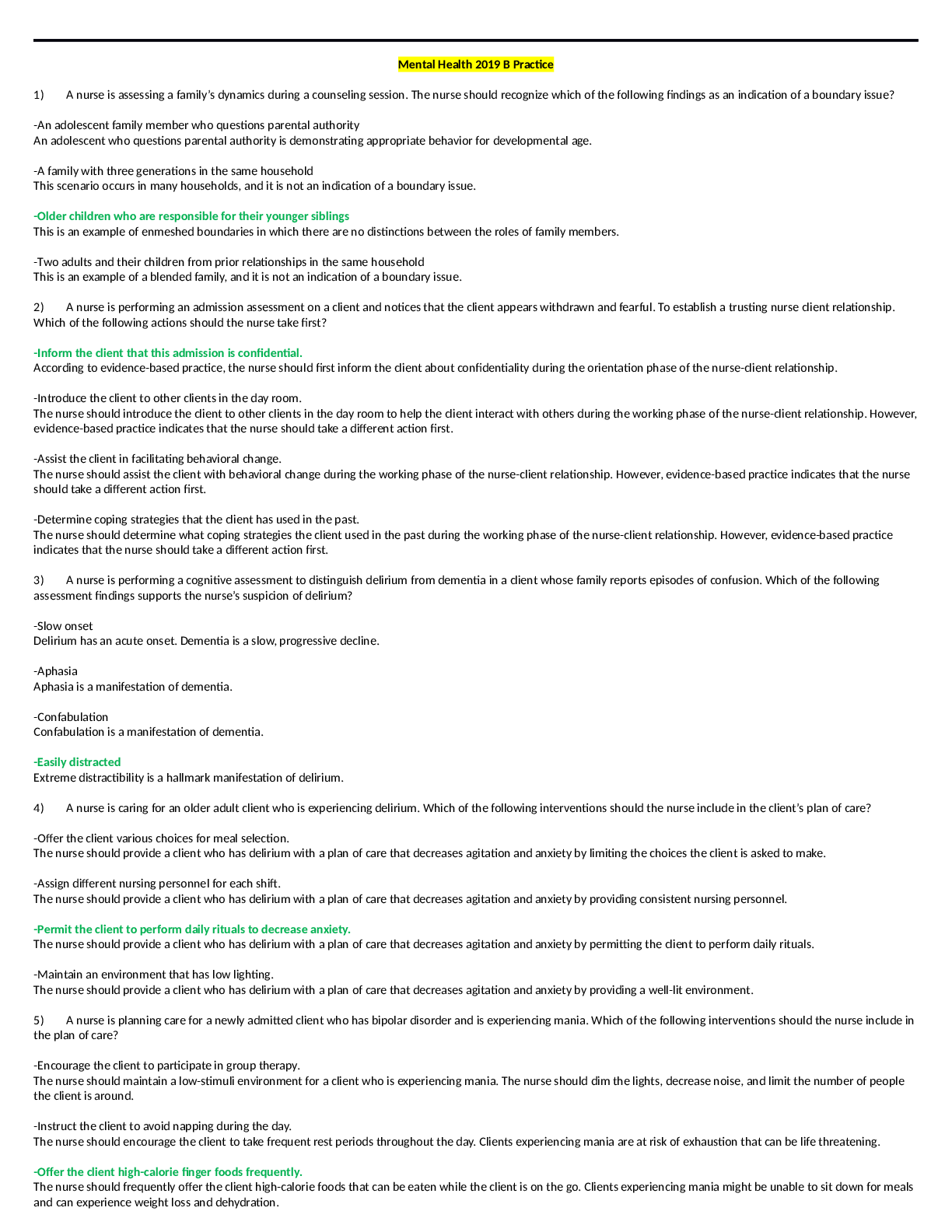
Reviews( 0 )
Document information
Connected school, study & course
About the document
Uploaded On
Nov 07, 2021
Number of pages
14
Written in
Additional information
This document has been written for:
Uploaded
Nov 07, 2021
Downloads
0
Views
139

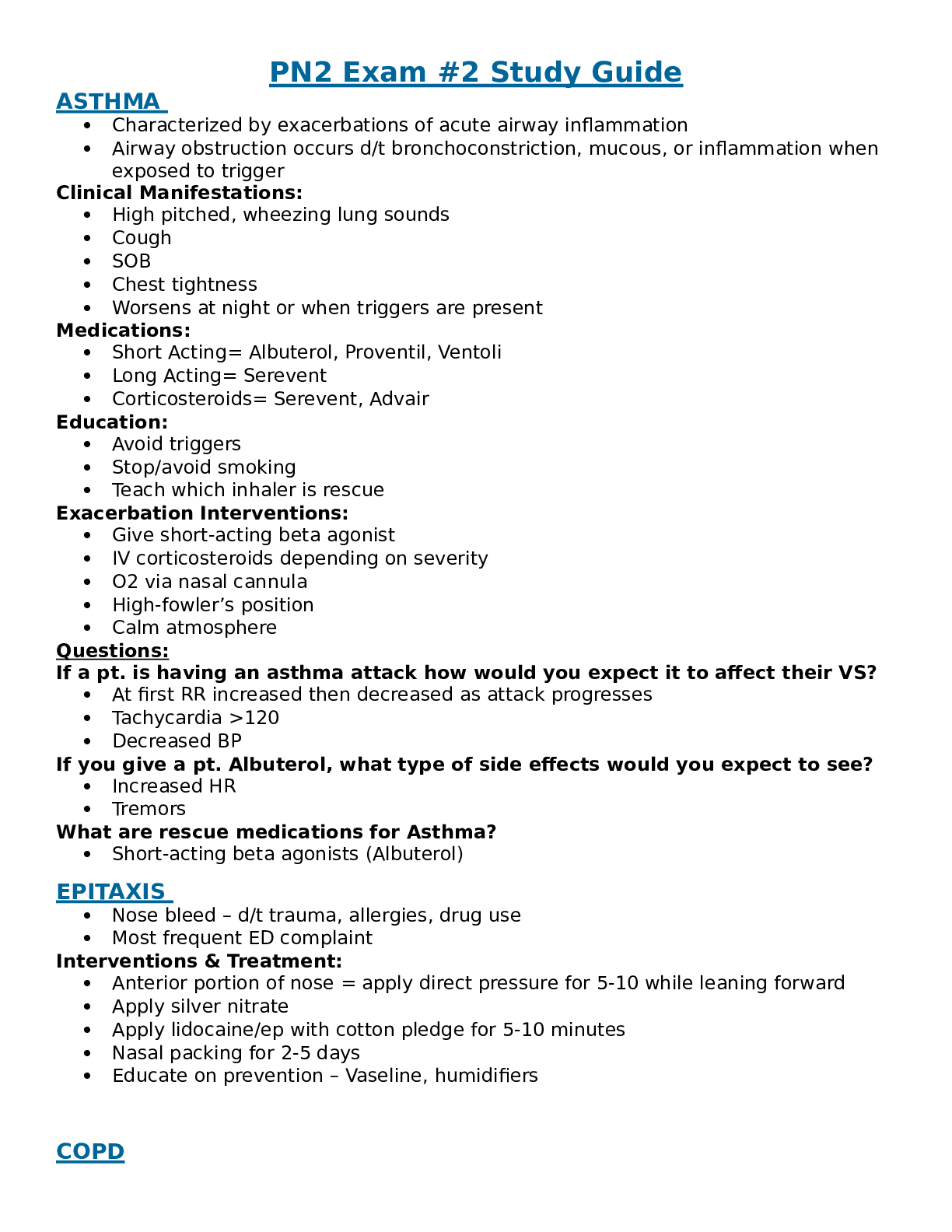

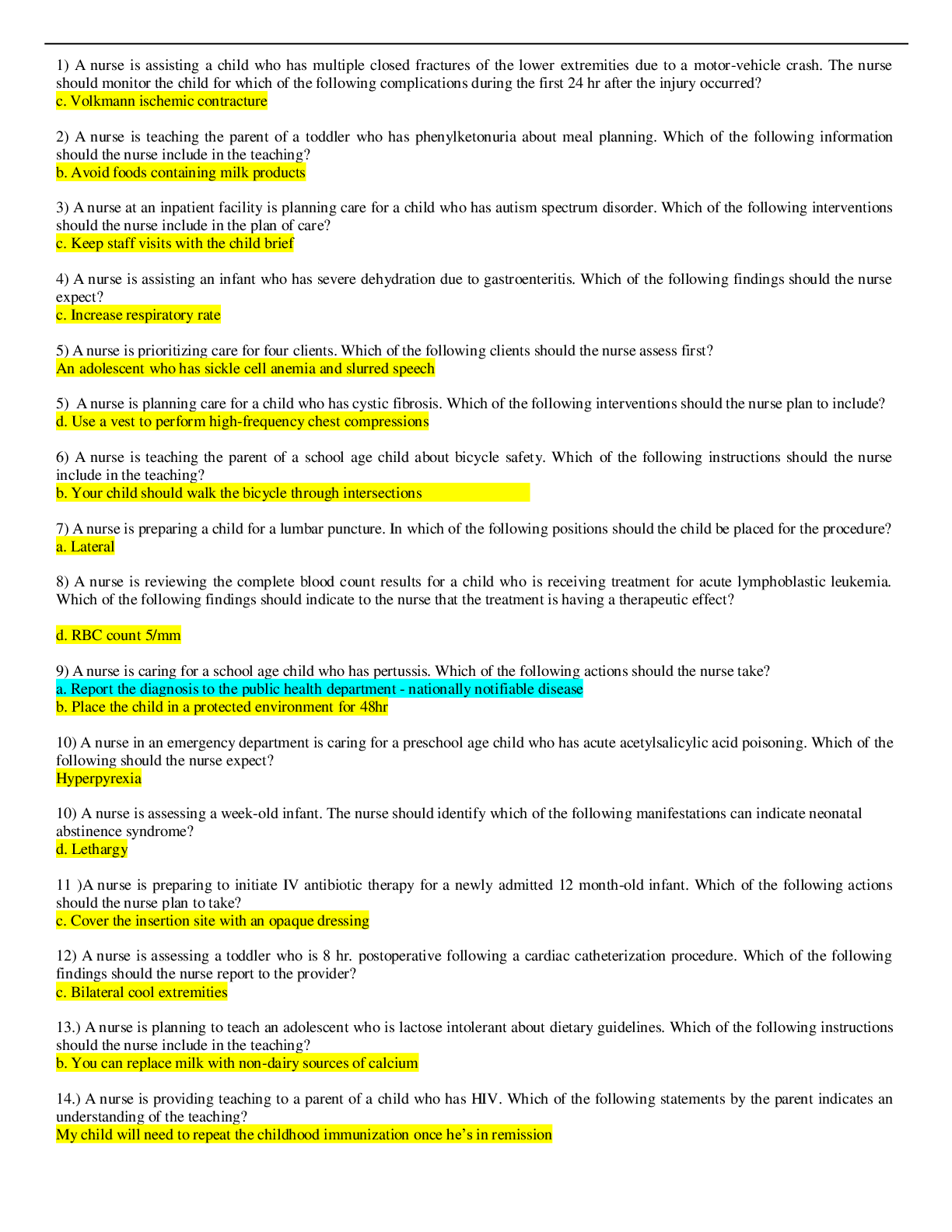
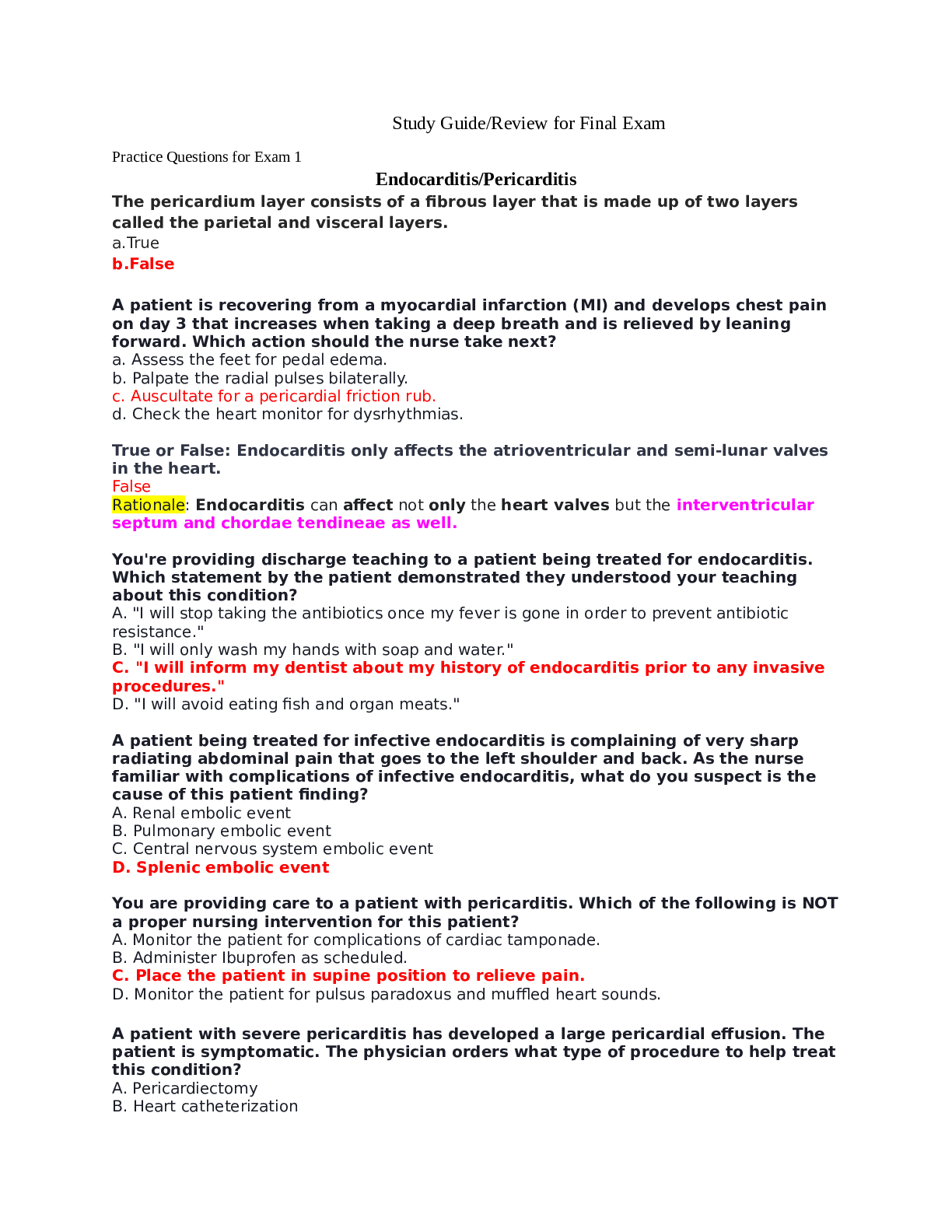
.png)
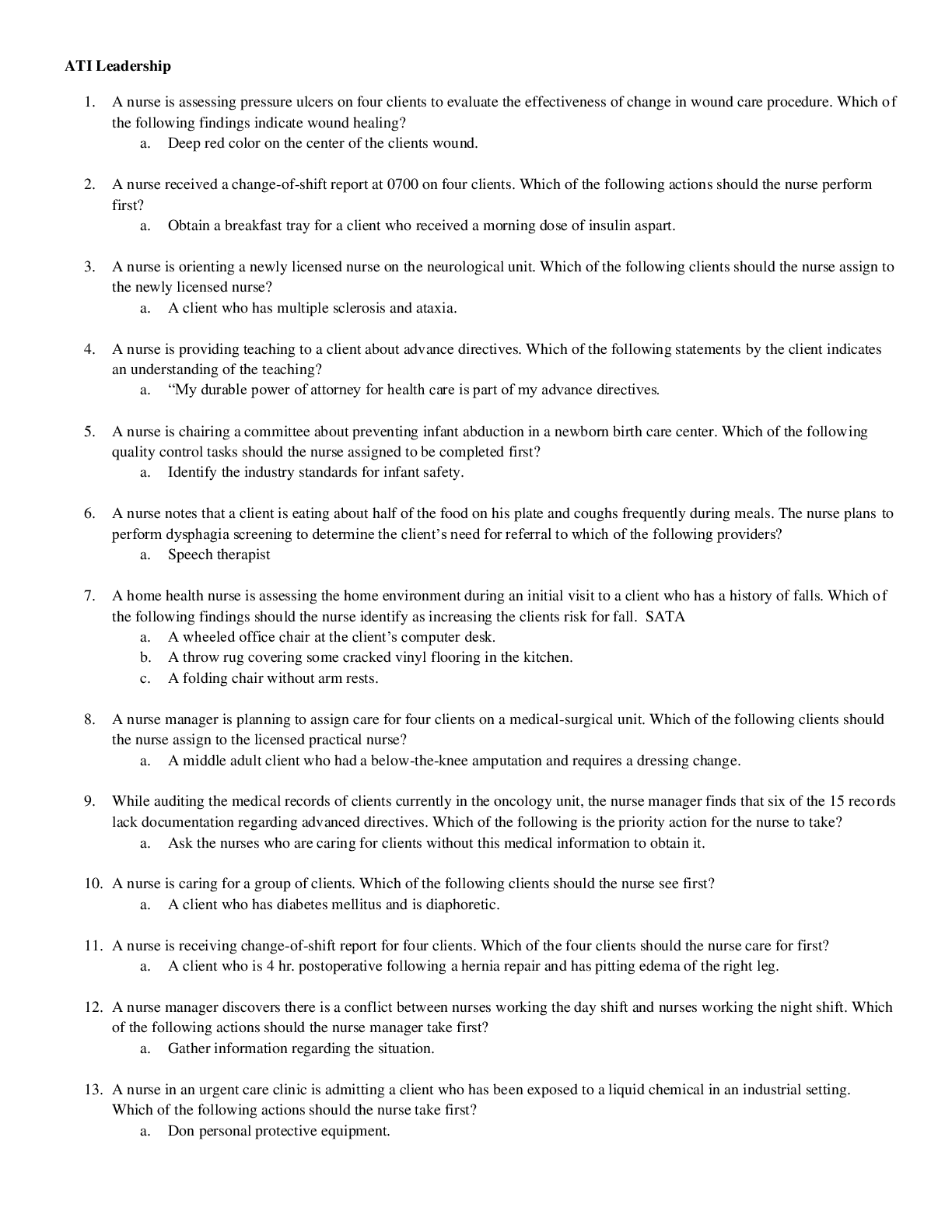
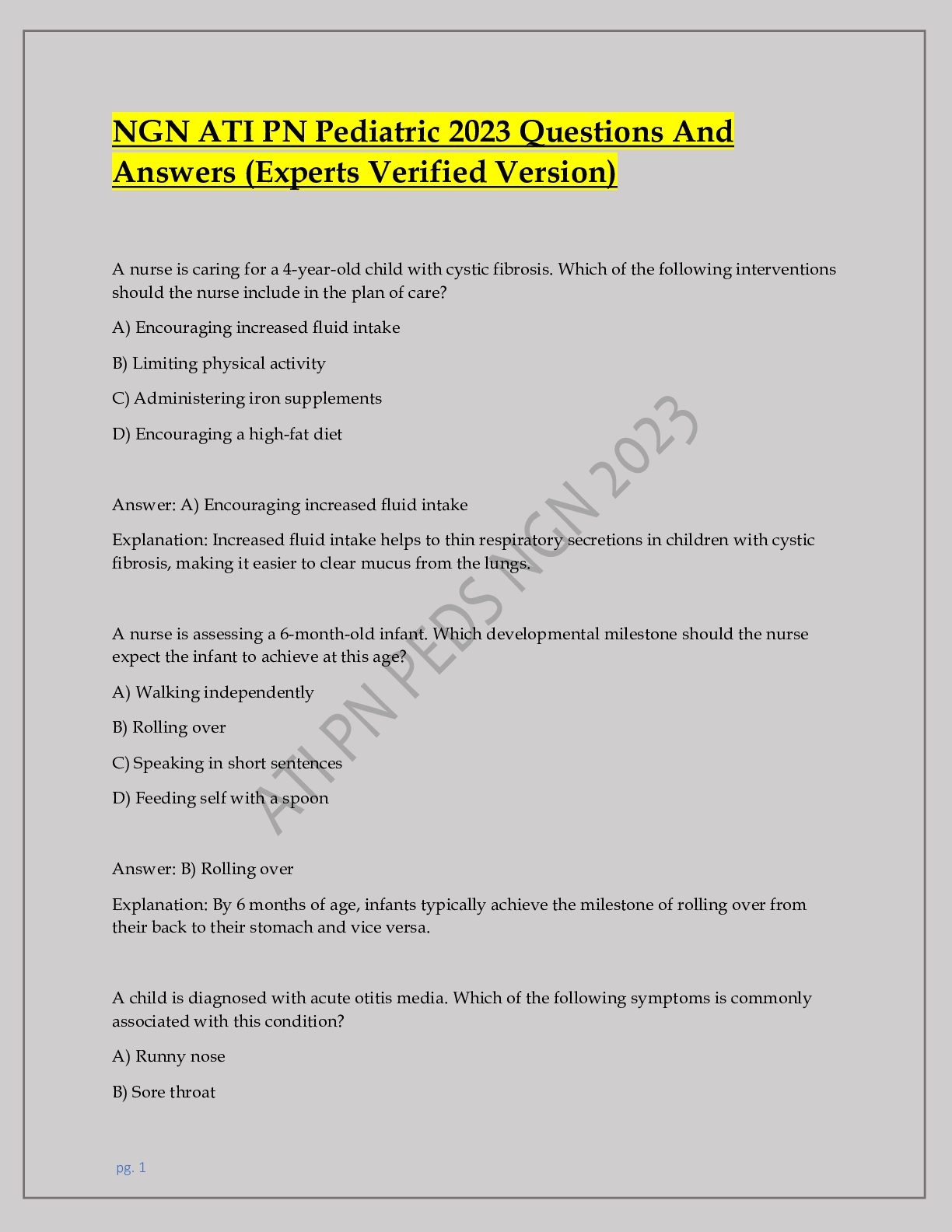

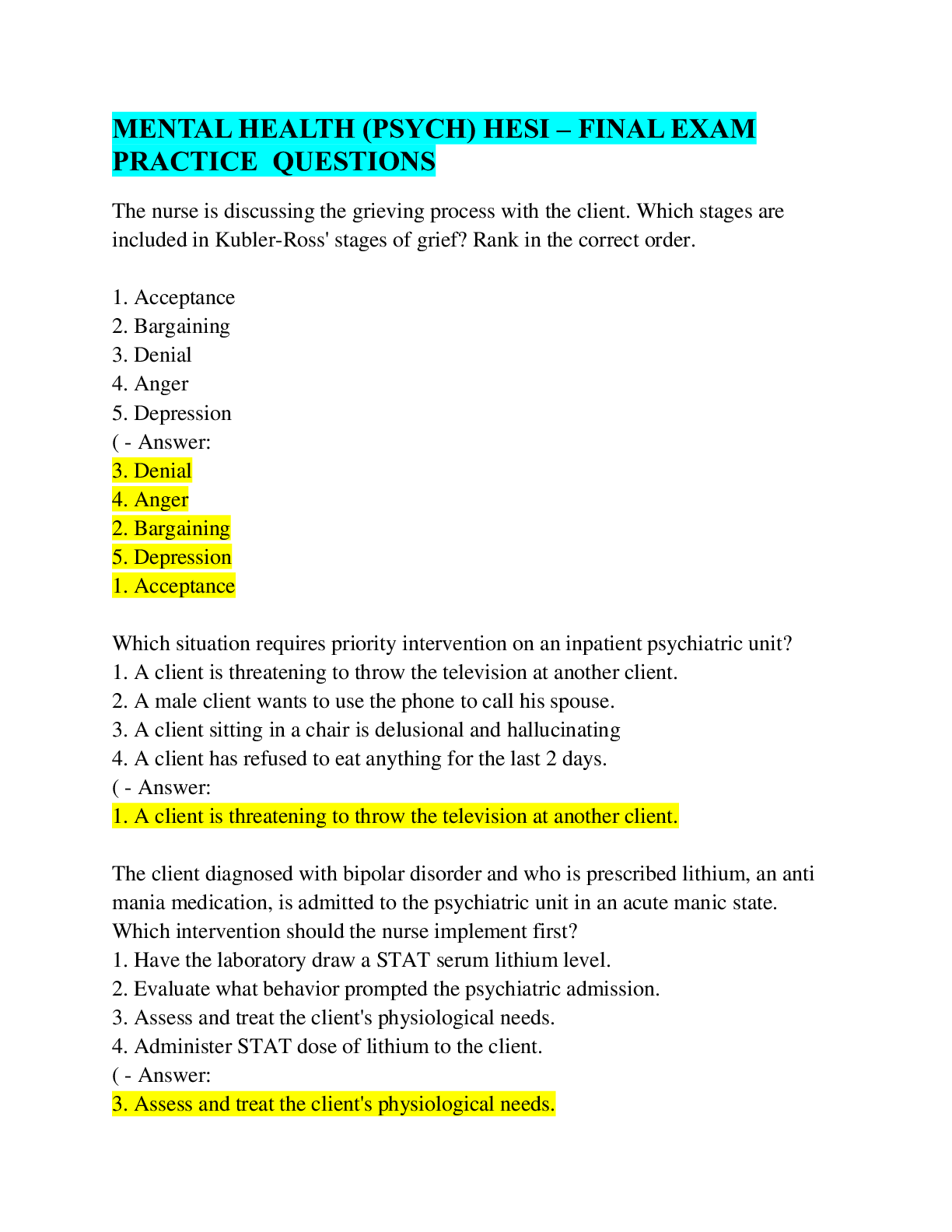

_Already Graded A.png)
